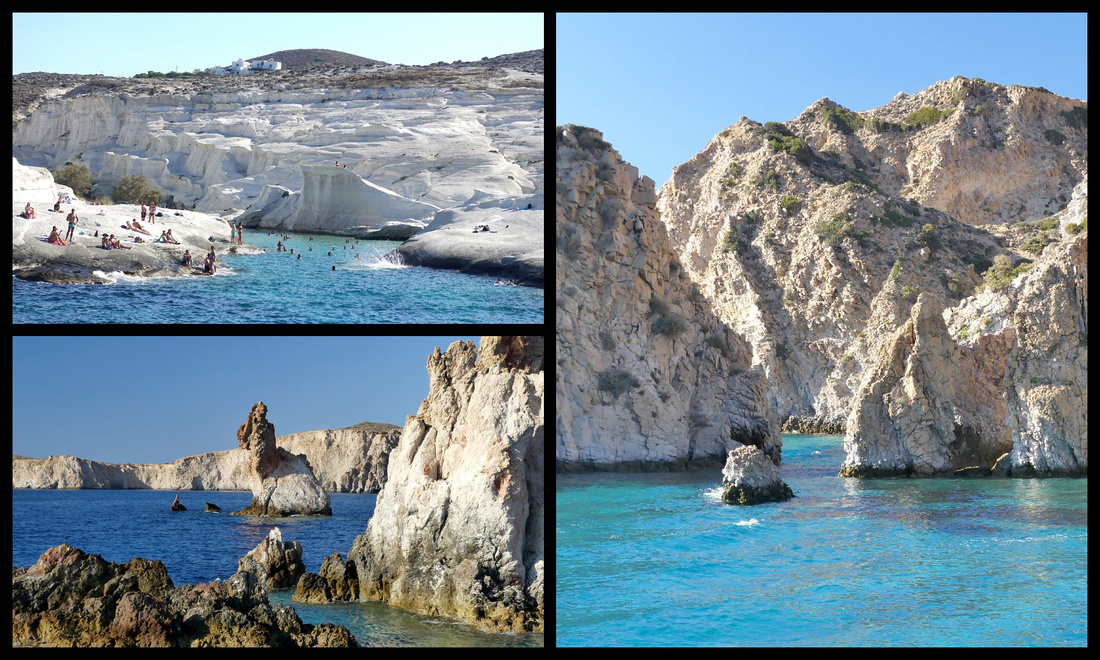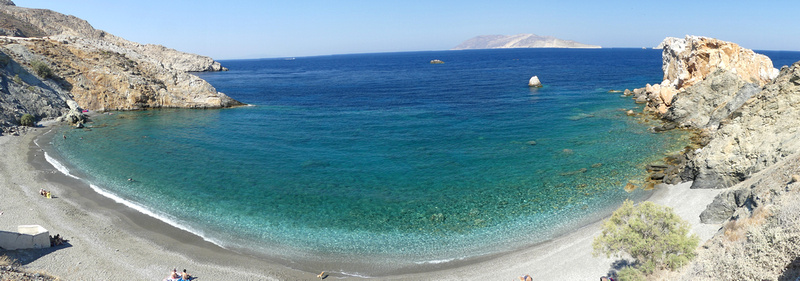


Greek Island Hopping 2018: Part 2 Milos, Sifnos and Folegandros
This was my third trip to Greece and my goal, other than just being on Greek islands, was to experience some slightly less popular islands. Previous trips included Santorini, Naxos, Paros and Crete - all of them among the most popular. The western Cyclades are less popular than some of the other islands in the group but that meant they were delightfully uncrowded, even in mid July. None of them have international airports but are easily reached by ferry from either Athens (Piraeus) or Santorini.
Folegandros Φολέγανδρος population 650, is a small island, barren and arid with tall hills (300 m above sea level). I had read that if Santorini didn’t exist Folegandros would be famous. The main town, Chora, is one of the more aesthetically picturesque, traditional villages of all the Cyclades islands, and the view is wonderful. It is perched high on a hill, and there are dramatic cliffs down to gorgeous blue and turquoise water. But there is no ‘caldera’ type view, and no villages perched on the edge, spilling down the slopes as in Santorini. It's a very "quiet" island.
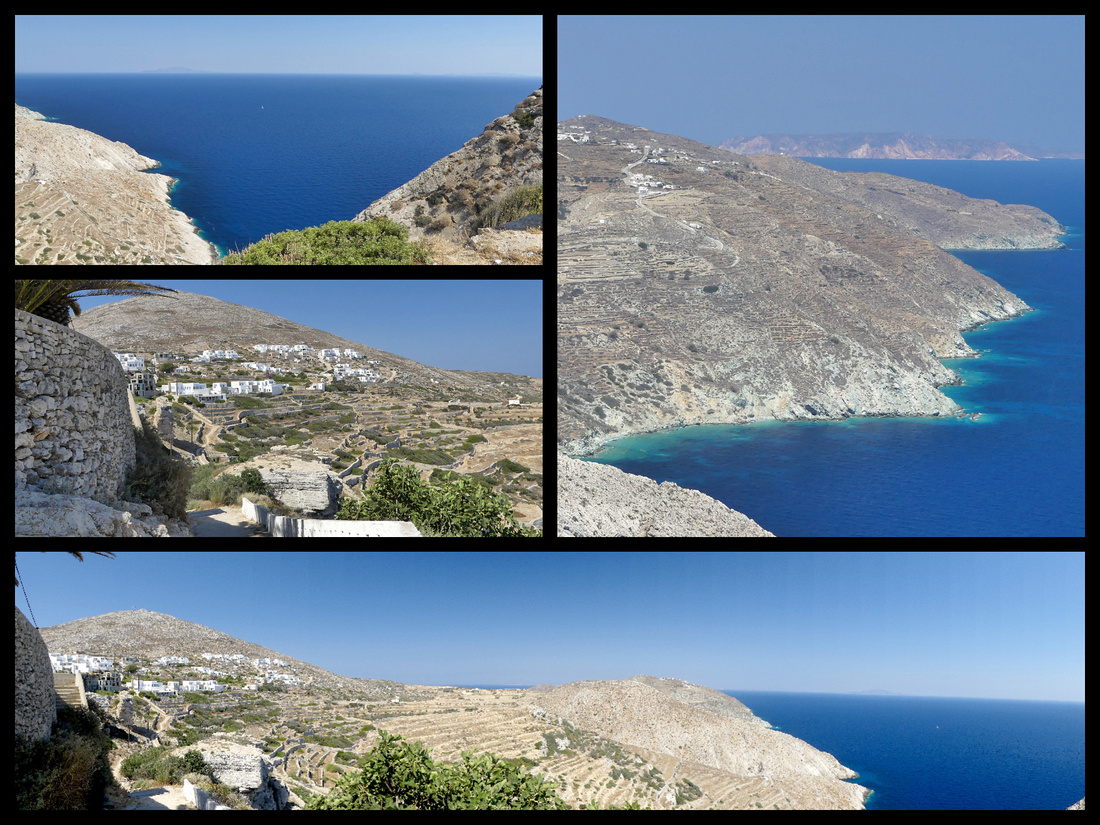

The only town of any size is Chora, small and totally pedestrianized, one ‘main’ square with numerous restaurants and several lanes going in all directions; narrow little alleyways, white stonewalls, courtyards, wooden balconies and Aegean-style churches.
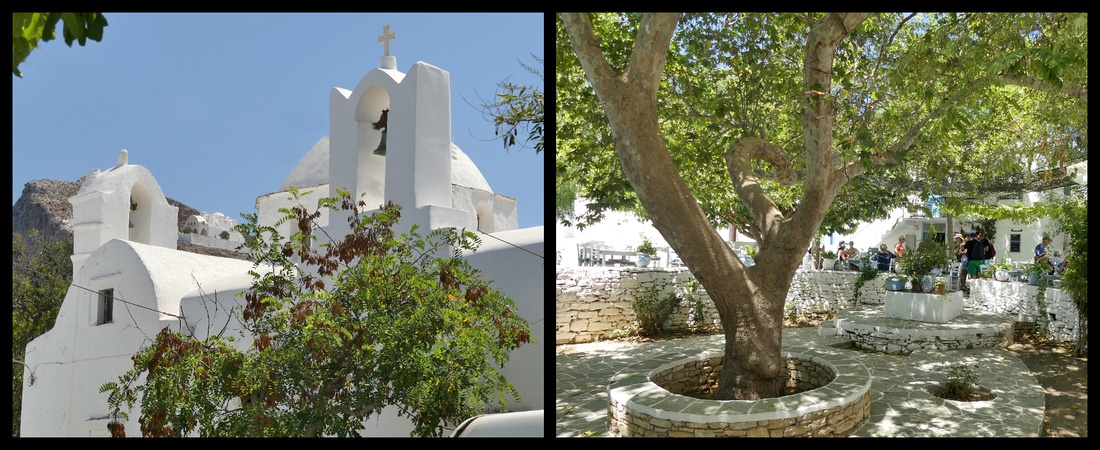



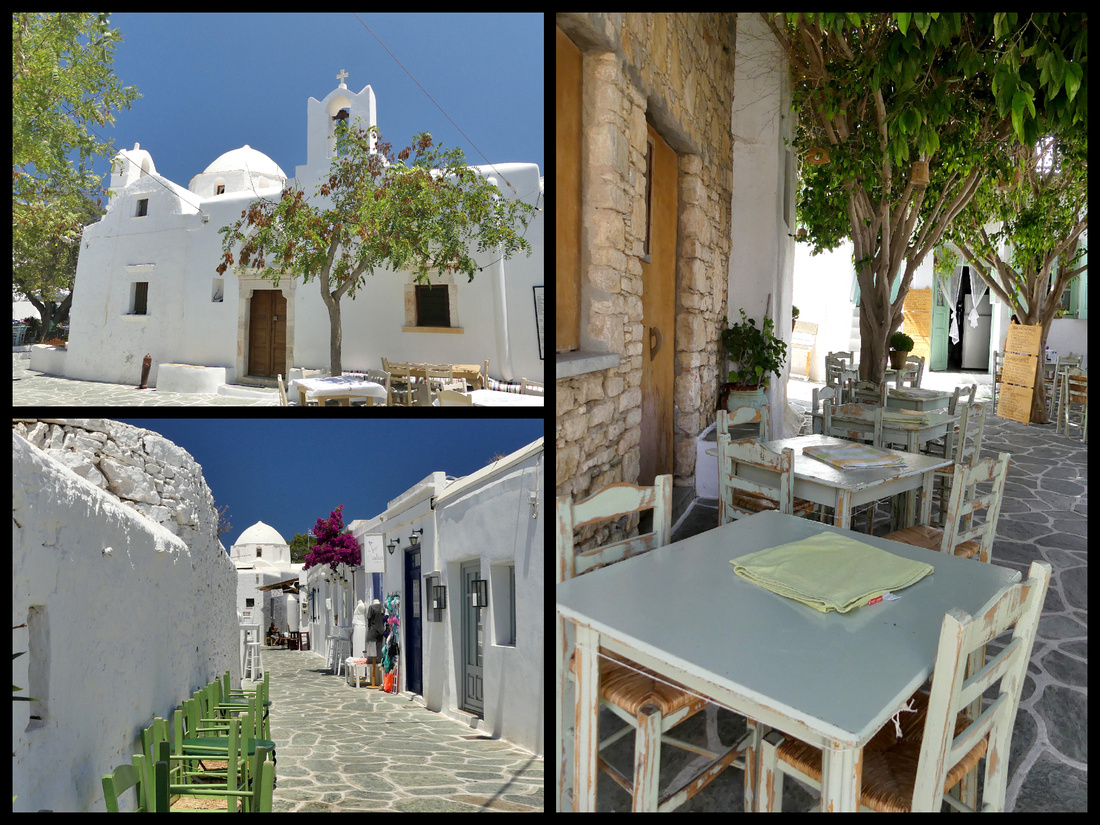

The most interesting part is the Kastro, a medieval-era district (former Venetian fort) that makes up part of the main town, essentially two really narrow alleys marked by ranks of 2 storey houses, repetitive, almost identical stairways and slightly recessed doors that are very appealing. The houses are all white with trim painted in shades of blue and green.
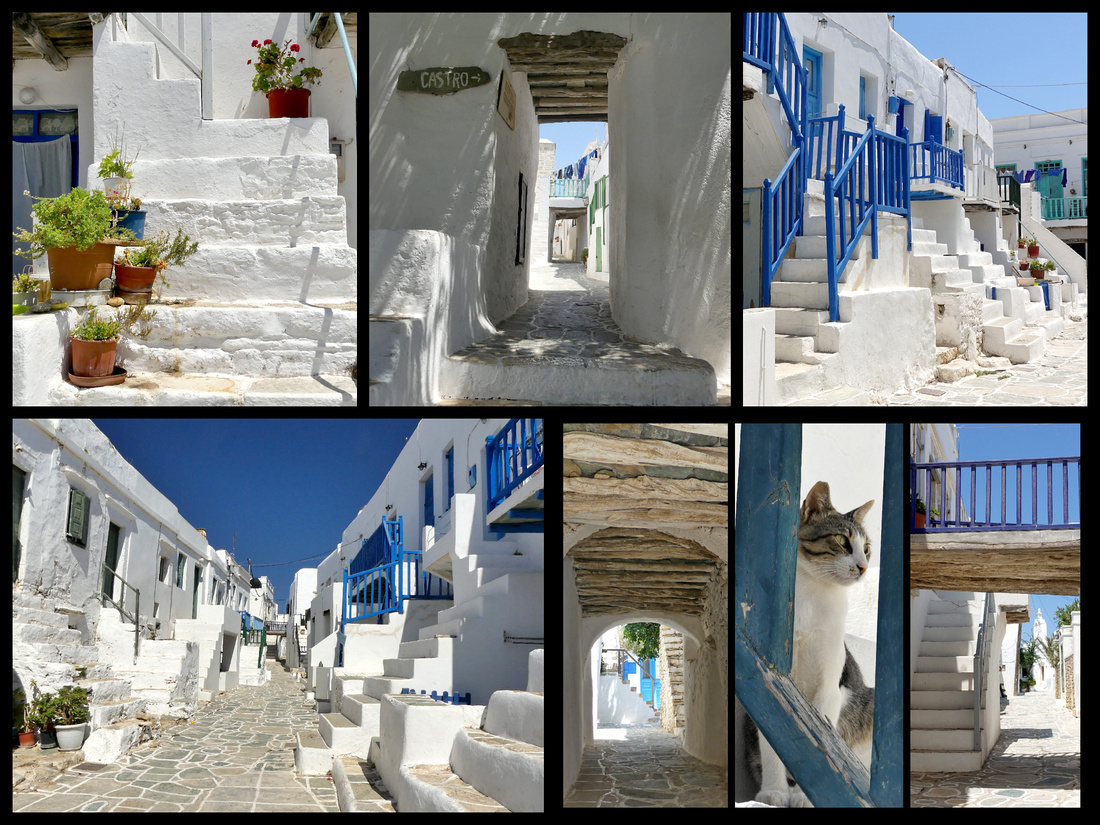

I had just about 48 hours on Folegandros. I stayed at Vardia Bay Studios, which is a 5-minute walk up the hill from the dock (although the hotel sent a mini van to the dock, mostly I think to take other guests to their sister hotel up in Chora, but they drove me right to the door of the hotel). I had a spacious studio with little kitchen and balcony. Around the back is the beautiful Vardia Bay beach. I arrived around 9:30 so of course my room wasn’t ready so I left my bag and took the bus up to Chora. The bus goes up to the 'Chora' from the port about hourly and only takes 5 minutes. It’s only about 4 km(2 miles) and I had read that it was ‘walkable’ in 45 minutes. Well that may technically be true but it would be a horrible walk, very barren, not interesting, no shade, uphill. I frequently walk when people say to take a bus or tram but no way I’d do this one, even down hill. Chora is 650 feet above the harbor.
After thoroughly exploring the town (which took about an hour, even photographing every doorway, alley, and cat) I went to the one bakery and got a cream pie and frappe and enjoyed it with a book and a cat at a little table in the small square. Then I ‘hiked’ up to the chapel above town.
Above Chora, a striking white path zigzags across the face of the mountain up to the church of the Panagia (St Mary). The walk is not as bad as it looks, took me about 45 minutes up and back including quite a while sitting inside. The church is a rare example of Aegean ecclesiastical architecture with three domes. Built on the ruins of the ancient sanctuary dedicated to the goddess Artemis. The sign (and my research) say it is open from 6pm-9pm but it was open at 13:00 in the afternoon the day I was there. They are doing some renovation on part of it and there were a couple workmen up there, perhaps that’s why it was open but it was very nice inside so I’m glad I got to see it. The inside of the main dome is blue. There was also a ‘box’ of water and cups – don’t know if that was for the workmen or the tourists but it was nice after the walk up in the blazing sun. I passed about 5 or 6 people in each direction – no tour groups, no crowds, so peaceful.






The port town (Karavostasis) is tiny, few restaurants/small market, tiny boat harbor (fishing, pleasure and ferry) and a couple beaches. One is the harbor beach, the other, around the backside of the tiny peninsula that Vardia Bay Studios is on, named, Vardia Bay, is small but secluded and quite lovely. Other than go to one of these beaches or have a meal, there is quite literally nothing to do in Karavostasi (the port town). There is one boat that does a cruise around the island a few times a week, and another smaller one that goes back and forth to Katergo beach, about a 20 minute sail, stopping for a minute at a little sea cave. That beach is very pretty, but small and really no better than Vardia Bay. The water at both beaches is crystal clear, light turquoise and warm.
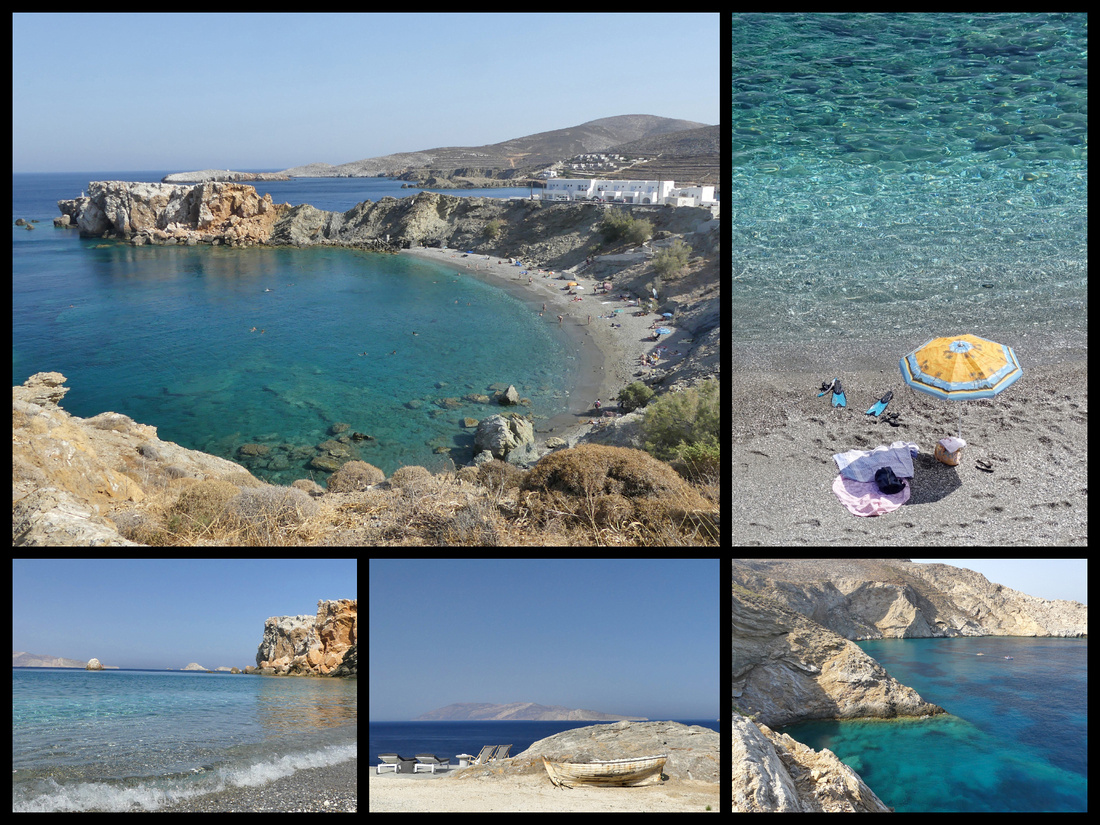
 Above: Vardia Bay
Above: Vardia Bay
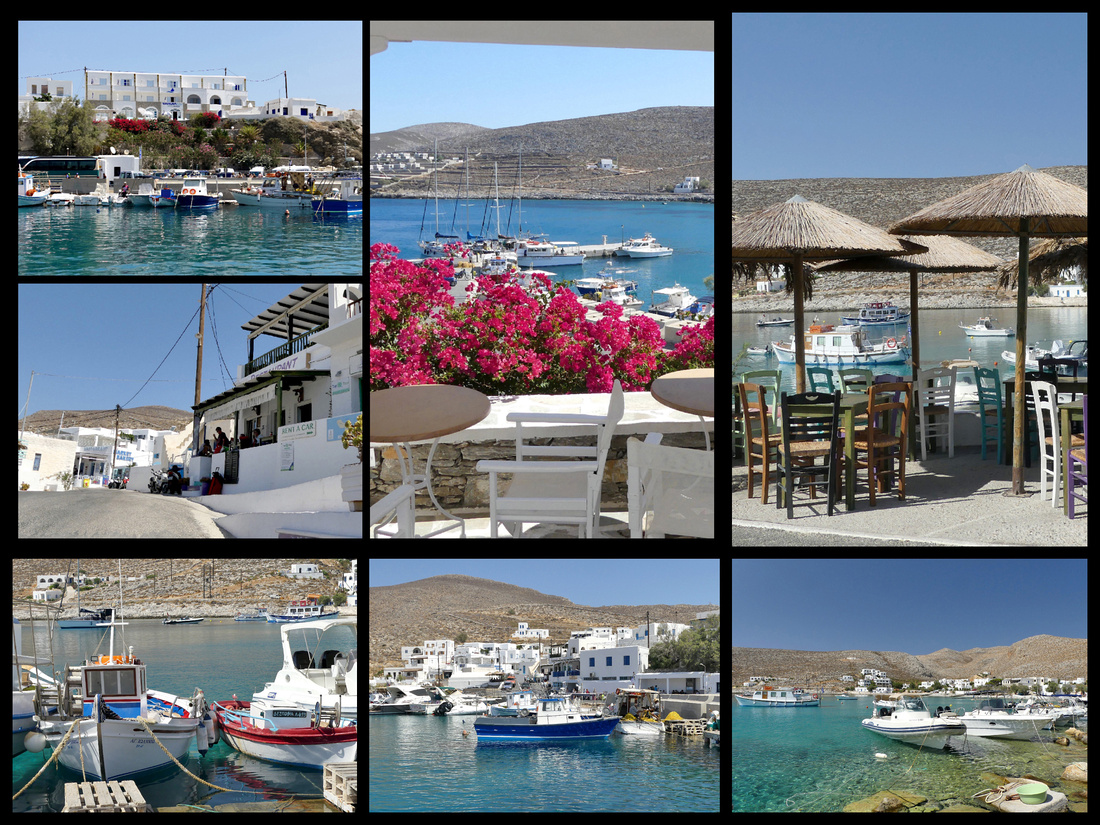

The tiny port town. Top left photo is Vardia Bay Studios, middle top photo is the view from terrace .
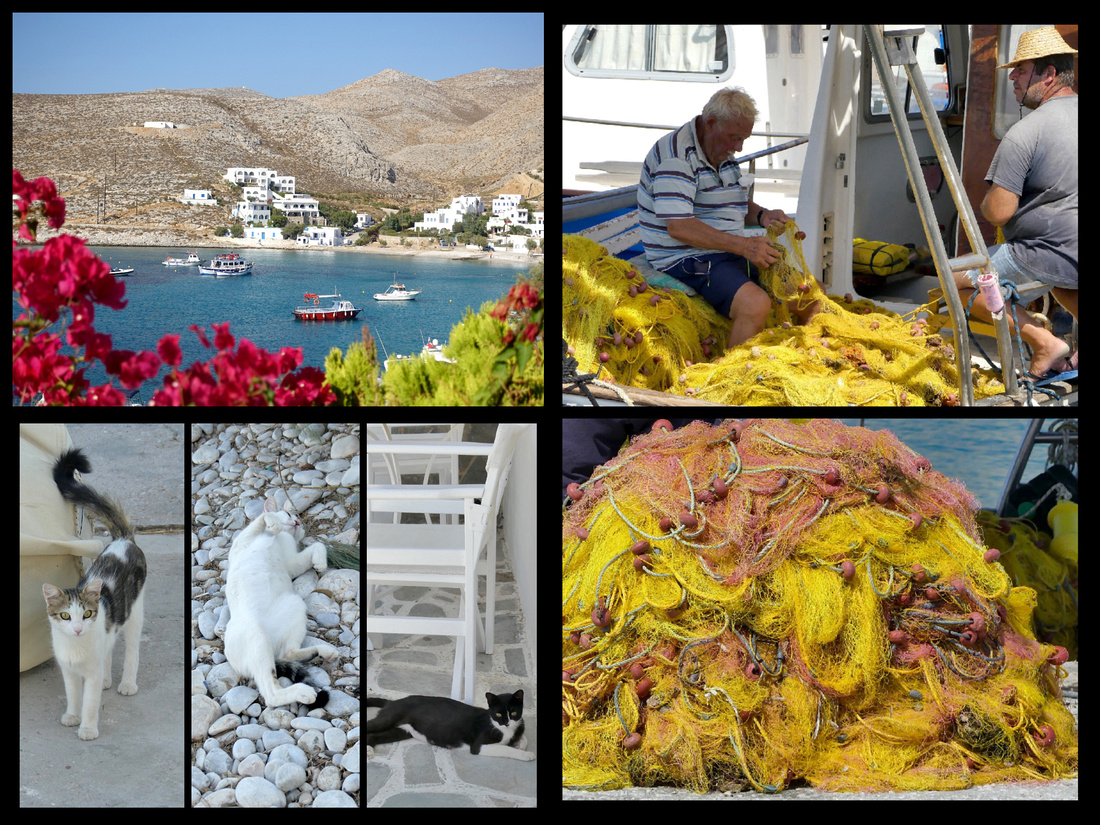

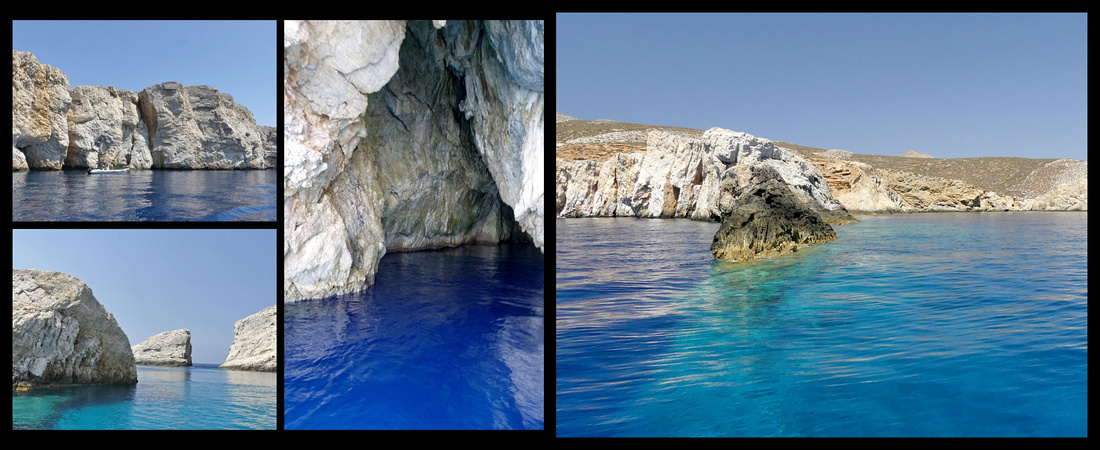

Above: images from the boat ride to Katergo Beach


Above: the smaller boat does the 'shuttle' back and for to Katergo Beach - which is the right photo. The larger boat does the circle around the island cruise, but only a few days a week.
This is definitely a 'laid back' island. There are some luxury resorts here and I think it's become popular with people who want a spa vacation on a beautiful island. But it is really quiet and peaceful and feels like what a Greek island must have been like before the tourist onslaught. Some of the guys in the main square were playing backgammon, others walking around with worry beads. There are a few shops in Chora selling clothing, jewelry and ‘souvenir’ type things. But certainly nothing on the shopping scale or with dining choices of any of the other 7 Greek islands I have visited.
Milos μήλος population 4500 Adamas Port in Milos is MUCH bigger than the port town in Folegandros, and to me much more inviting and interesting. Nowhere near as chaotic as Santorini though. I stayed at Hotel Delfini, to the left as you leave the ferry, about a 5 minute walk – just follow the harbor till it turns, past the small beach, and one block further.

 The beach in Adamas, the Hotel Deflini, one block inland from the beach.
The beach in Adamas, the Hotel Deflini, one block inland from the beach.
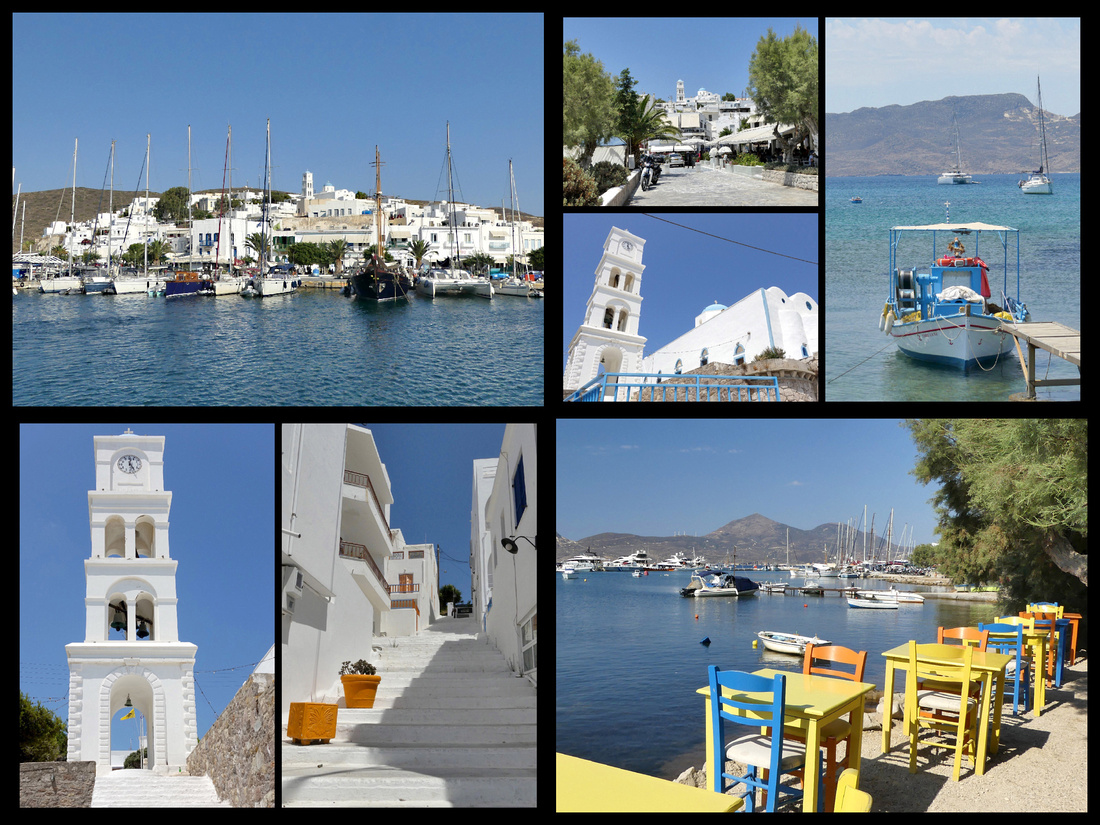

The port town of Admas is in a large bay that is considered the safest in the Aegean (was used by the Germans in WWII). Built on a small hill (topped with a white church) sloping down to the harbor filled with sailboats, yachts and day cruise boats. A few fishing boats off to the side. Large enough to have a selection of restaurants, tavernas, ice cream shops, bakeries and shops. There is a fairly large grocery store with pretty much anything you could need at prices way below mini-market prices. The bus stop is across from the bakery under the Portinia Hotel, just as the harbor road turns, a block from the ferry dock.
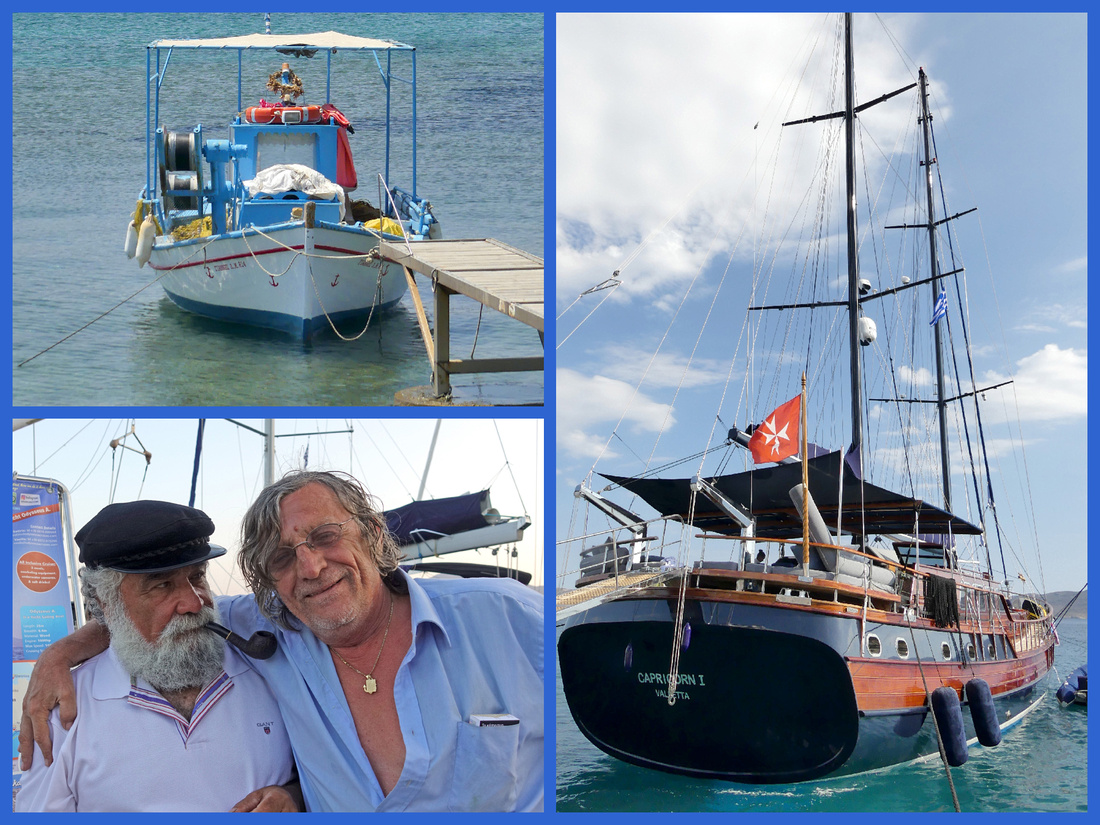

They say that besides Santorini, Milos has the most extraordinary terrain of any of the Cyclades due to its volcanic past. There are amazing rock formations, incredible views, and as many as seventy beaches. Lots of coves and sea caves. What they don’t say is that most of the beaches are tiny and only accessible by boat (or by climbing down long ladders from the cliffs above). Milos has vast mineral deposits and a fairly large (for a Greek island) mining industry (there is a mining museum). The varied mineral deposits make for an abundance of colors of rocks around the island. Milos emerged from the Aegean Sea during a period of intense volcanic activity. The contact of the emerging red-hot material with the seawater resulted in the creation of rocks and formations in an astonishing variety of colors and shapes. The flow of lava when the island was created also accounts for some amazing landscapes. It reminded me of Death Valley – only in the middle of the sea.
An excursion sail around the island and to the neighboring island of Kimolos is the best way to see Milos' amazing coast. There are full and half day cruises. Each evening around 7pm all the boats have come in from the day's sailing and line up along the promenade and sell cruises for the following day. The ‘best’ I though was the €40 Captain Yiangos – it’s a ten hour tour that stops for lunch at the island of Kimolos plus 3 or 4 stops to swim off the boat, including at Kleftliko. All the other cruises were more expensive, did not include Kimolos, some only went part way around the island, and included (what reviews say is pretty bad) food. The boat was big enough that you could move around, get out of the sun, etc. There’s a snack bar for cold drinks at prices less than mini-market prices.
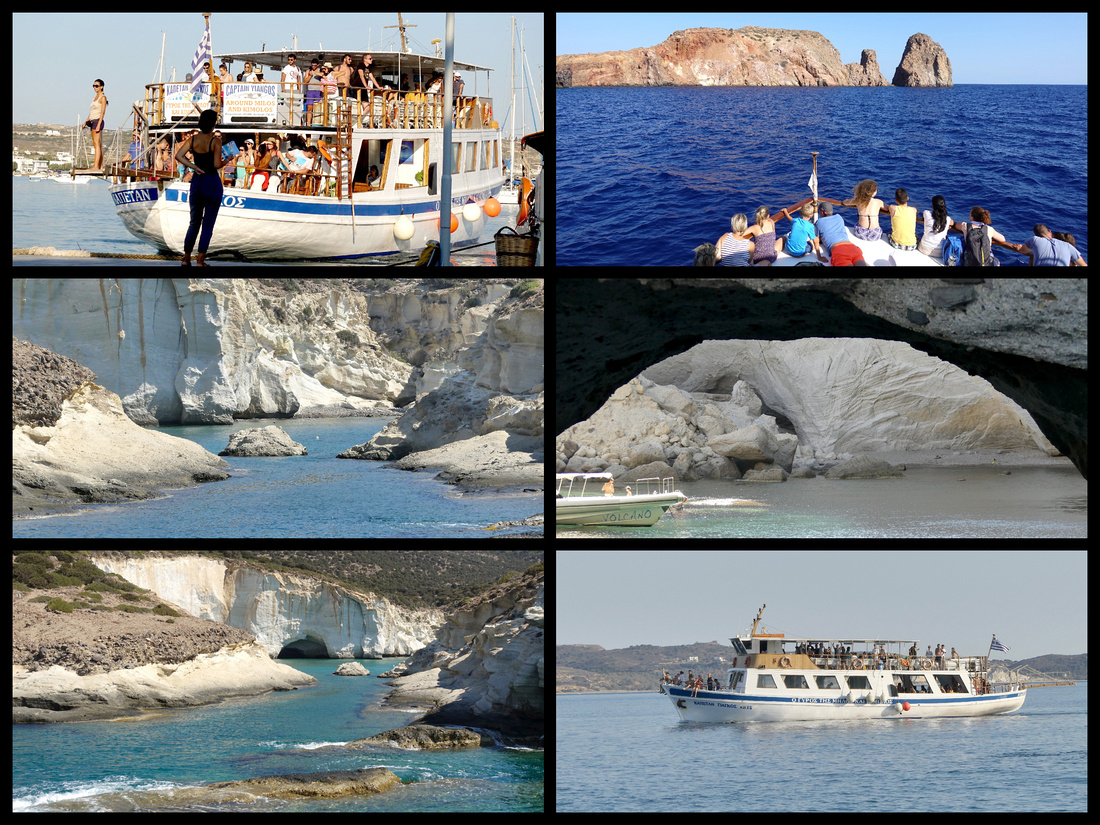



The cruise departs from the harbor in Adamas and sails half way around the island, stopping at the most outstanding feature of Milos, Kleftliko - huge white rock formations jutting out of turquoise water with caves and arches - for about 45 minutes so people can swim or snorkel.
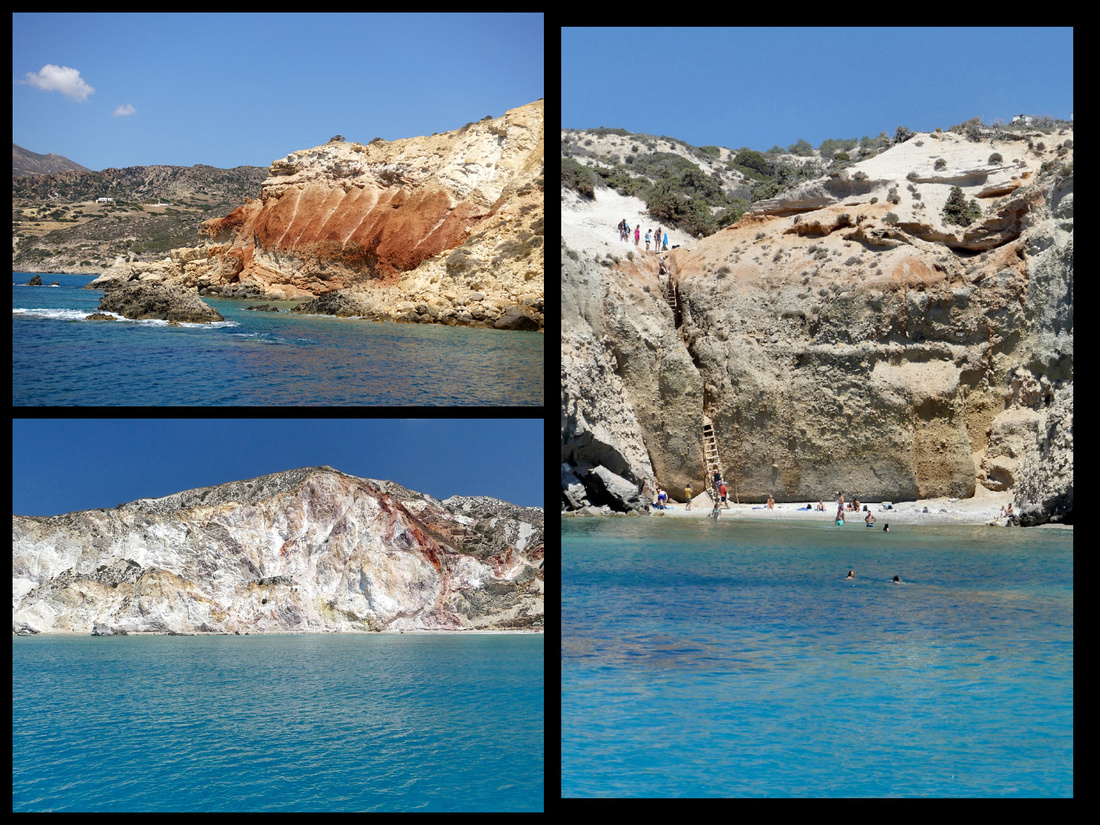

Above: Left - some of the amazing color combinations Right - one of the beaches accessible only by ladder from above
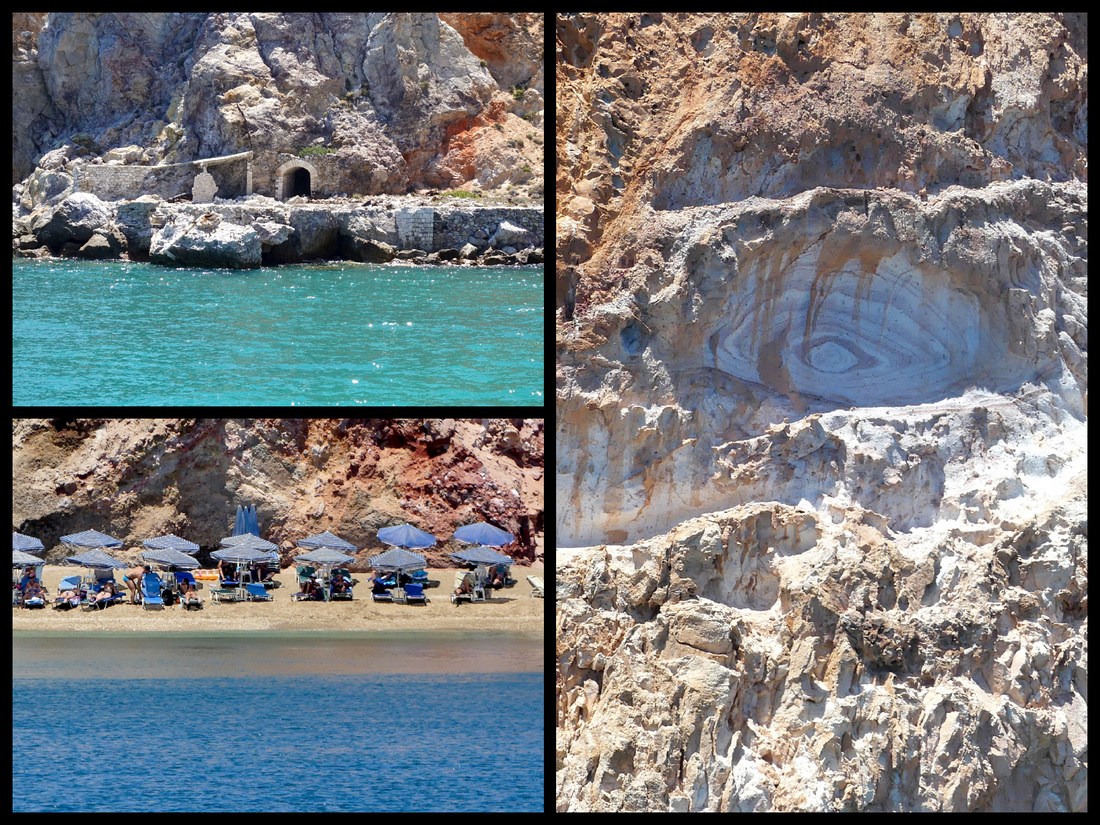

Above: Lower left - one of the few beaches accessible by car (and a walk) Right: the "eye" rock formation
The boat then stops for an hour or so for lunch at the neighboring island of Kimolos, a much smaller island just across a bay from Milos (from Pollonia). It has a small port (half dozen tavernas on the beach and one shop) and a larger (yet still tiny) town up on top of it’s hill. There is a ferry from Pollonia but very infrequent.
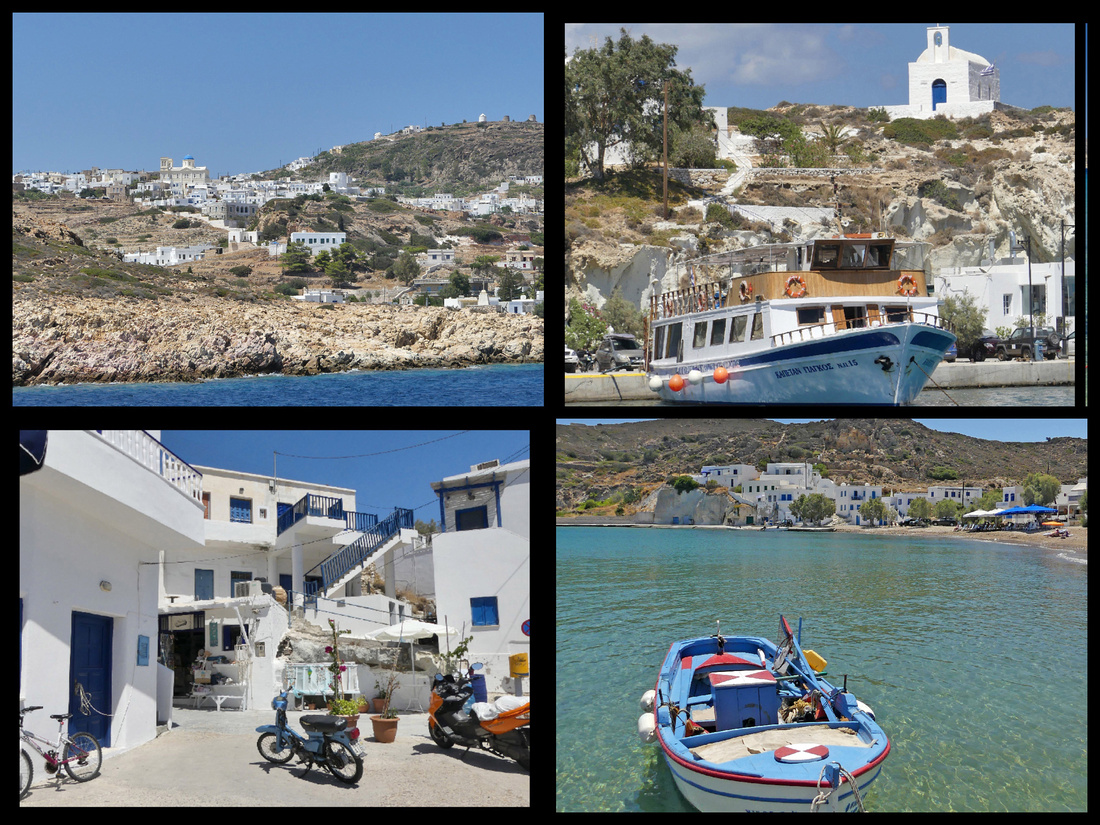

Above: Island of Kimolos Top right: the Captain Yiangos docked in Kimolos for lunch
Besides Kleftliko, the most outstanding feature on the coast is Sarakiniko, an area of bone white rock surrounding turquoise blue water that looks like a moonscape. The Adamos bay harbor is guarded by some unusual rock formations, the most distinct looks like a giant bunny rabbit.
Just before you enter the harbor (and around the tip of that part of the island) are three fishing villages that are unusual in that the houses are built right into the rock walls. They are referred to as ‘syrmata” and were built in the mid 19th century after fear of Turks or pirates abated so people began living right on the water, rather than up in the Plaka. They have brightly painted doors to their boathouses on the ground (sea) level, with living quarters above. Kilma is the largest, the other two are Mandrakia and Firopotamos.
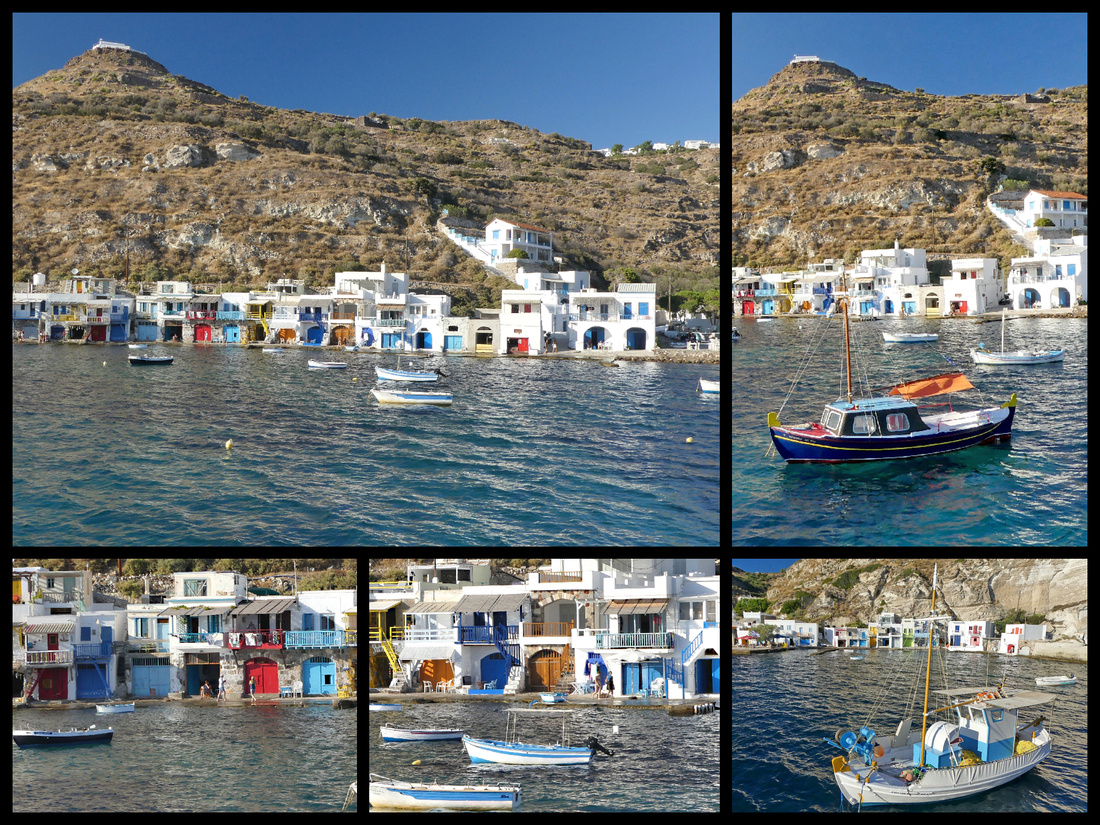

Milos' main village of Plaka is a typical Cycladic village with a warren of stepped and winding alleys lined with white buildings with lots of blue trim, plenty of bougenvalia and lots of small tavernas, with views out to the sea around every corner. There are three main churches, one in the center of the town, one half way up to the Kastro, and another at the top. Of course as in all the Greek islands, there are tons of tiny churches scattered all over. The island is rich with archeological sites including Christian catacombs, a roman amphitheater, and Venetian castle. The Venus de Milo was found here and a copy of the statue is in the small archaeology museum in Plaka. The Venus de Milo is actually Aphrodite, who rose from the foam of the Greek sea.


Above top left: view from Plaka, top right: copy of Venus de Milo in archaeology museum Bottom: Left & Center: Plaka streets, Right: view of Plaka from the water


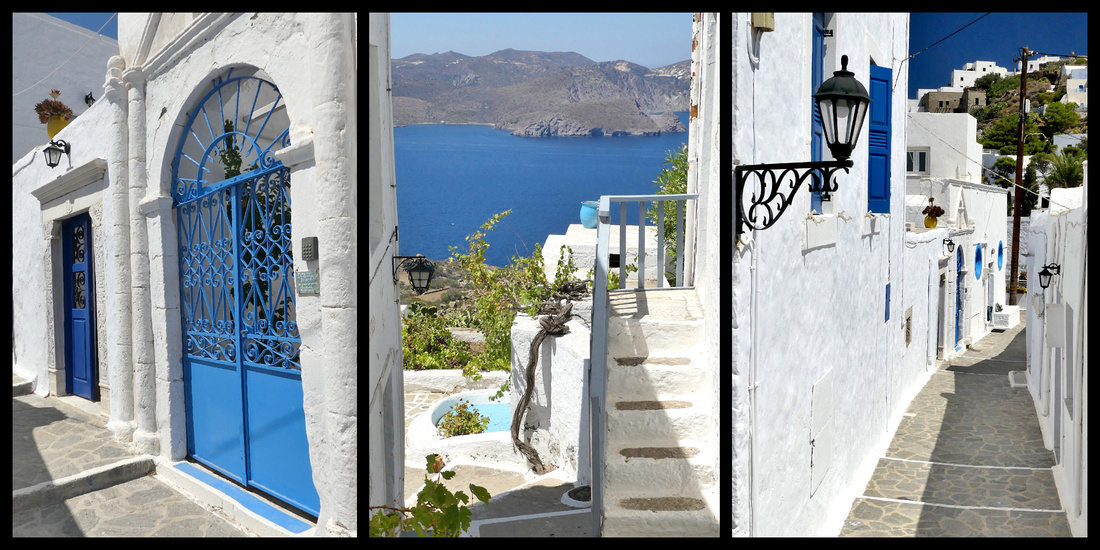



At the top of Plaka, on a steep hill 280 m above the town, is the old Venetian Kastro with two tiny churches. The Venetian family Sanoudoi, who since the 13th century had dominated the Cyclades and the Aegean, first inhabited it and used it as a stronghold against pirate attacks. The view from the very top, looking down on the slightly larger church half way up, the Plaka below, and the coast below that is incredible. Part way up the hill is the larger church, more steps lead to the very top where another smaller chapel crowns the hill and offers not only a 360 degree view of the entire island, but a beautiful view of the larger church below.
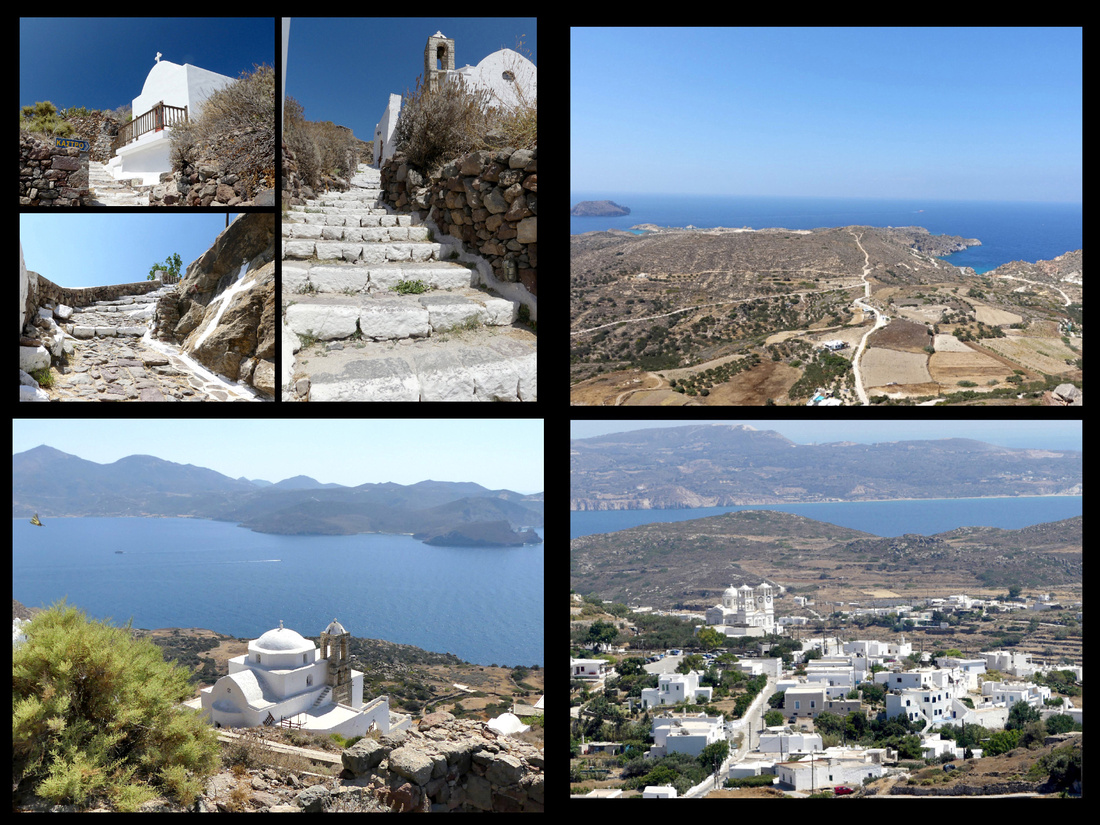
 Top left: Steps leading up to the Kastro from Plaka Top Right: view from Kastro
Top left: Steps leading up to the Kastro from Plaka Top Right: view from Kastro
Bottom Left: Church as viewed from very top Bottom Right: village of Tripiti below Plaka
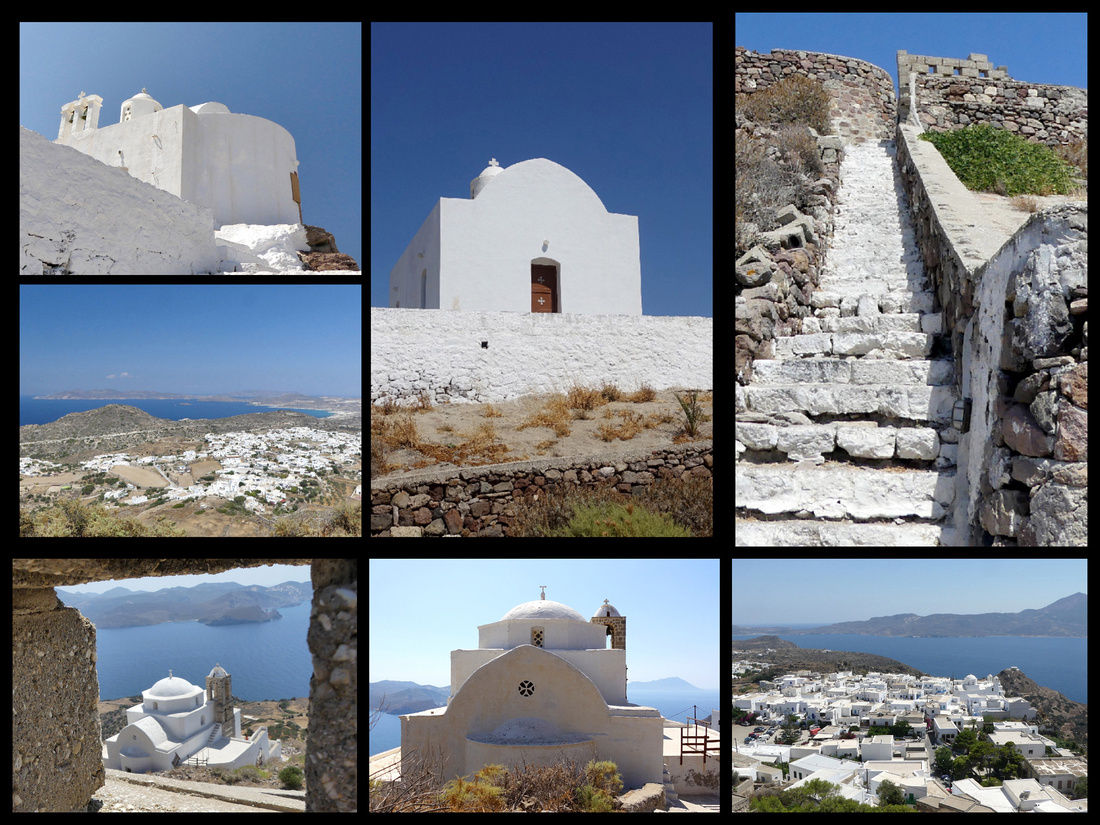

Top: Small chapel at the very top, and stairs leading up to it. Bottom: the larger church and view of Plaka from the top
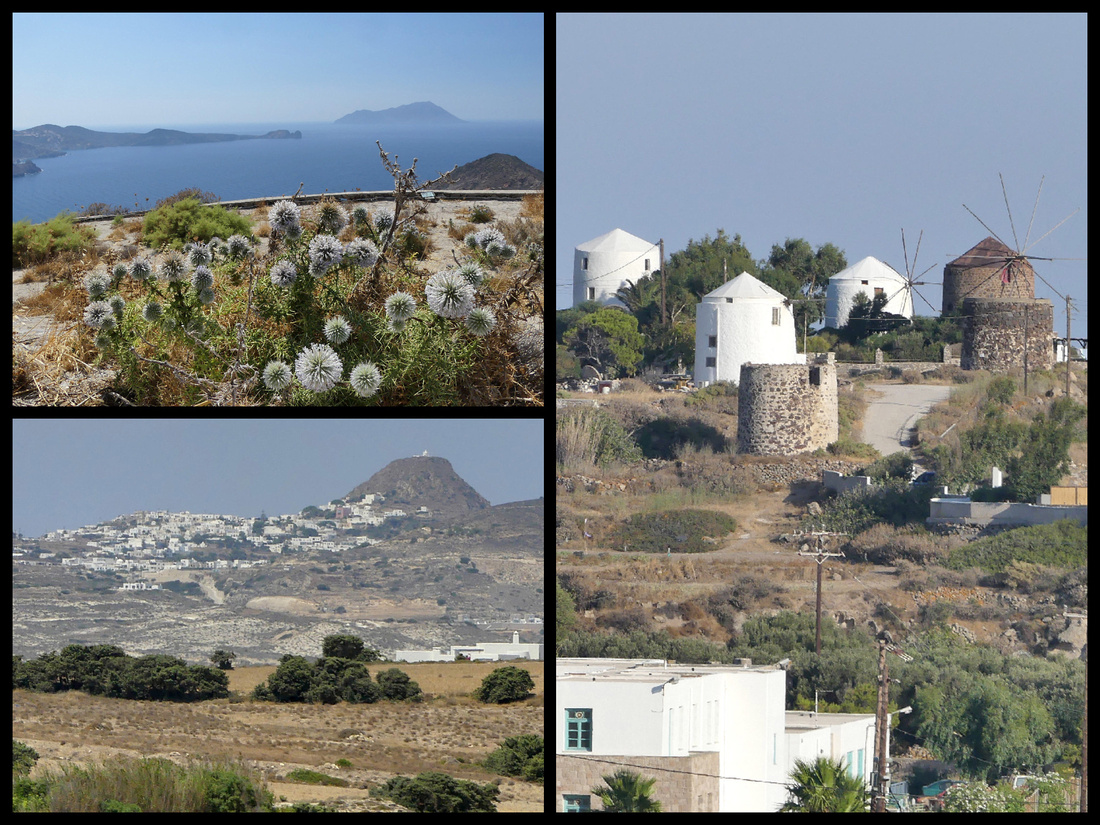

Top Left: view from kastro Bottom Left: view of Plaka, with kastro sticking up above from afar Right: windmill are found throughout Milos
Pollonia - is a small fishing village, built around a pretty bay, in the northeast of Milos. The church of the village, Agia Paraskevi, stands on a small peninsula, above Pollonia. A few hotels, mostly ‘rooms’ to let, a few tavernas and some pretty fishing boats, one or two shops. Beach is better than Adamas but not as amazing as some of the tiny secluded ones.


The buses go to most places with some regularity. They are about hourly to Plaka and Pollonia, every two hours to Sarakiniko. Of course most of the amazing coastline can only be seen by boat.
So between the buses and cruise you get to most of the island. To really see the tiny fishing villages and some of the beaches up close it wouldn’t be a bad idea to rent a car for one day (seemed to be plenty of places) – or if visiting in the spring or fall when the temperatures are more moderate, you can probably walk to a lot (e.g. the catacombs, Kilma). But you still need to do the boat ride.
What I did during 4 days on Milos: I arrived on the 10:30 ferry, was able to check into my hotel and explored a little of Adamas town. Then got the bus up to Plaka for lunch and the afternoon. I spent about 5 hours between lunch and exploring (photographing) the town and climbing up to the chapel on top of the castro. Words can’t describe the views, you have to look at the pictures. The climb up there is steep but only about 15 minutes. I saw a total of four other people. Back to Adamas for dinner.
The second day I went to Pollonia for half a day, spent the rest lazing around. That evening I went scouting for the best day cruise to take the following day. The boats all get back from their cruises around 7 pm and the crews stand out on the promenade trying to tell you why their cruise is better than the next guys, most also have pamphlets describing where they go, etc. The third day was the 10 hour cruise and the fourth day I went back up to the plaka – twice in fact. In the daytime to visit the archaeology museum where the replica of the Venus de Milo is (tiny museum, two rooms) and again in the evening for sunset. There were certainly other things I could have done, especially if willing to rent a car but by this time on my trip (I had been in Germany, Austria and Slovakia for almost 3 weeks before Greece) my energy level was sagging. I would say Milos is good for 3-4 days for the highlights, longer if you want to ‘see everything’ or spend extensive beach time.
Other than Santorini, I would say the sunsets from Milos are about as wonderful as they get - best view of course is from the top of Kastro above Plaka. But it's worth the hike.
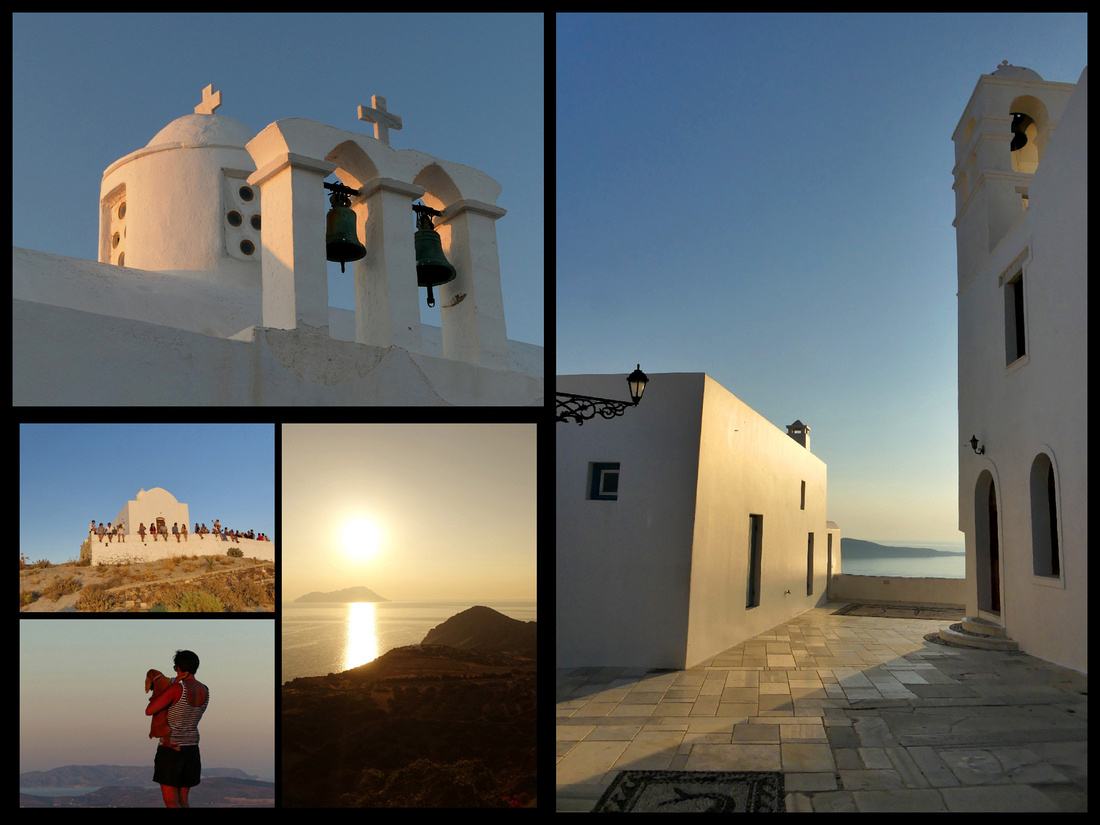

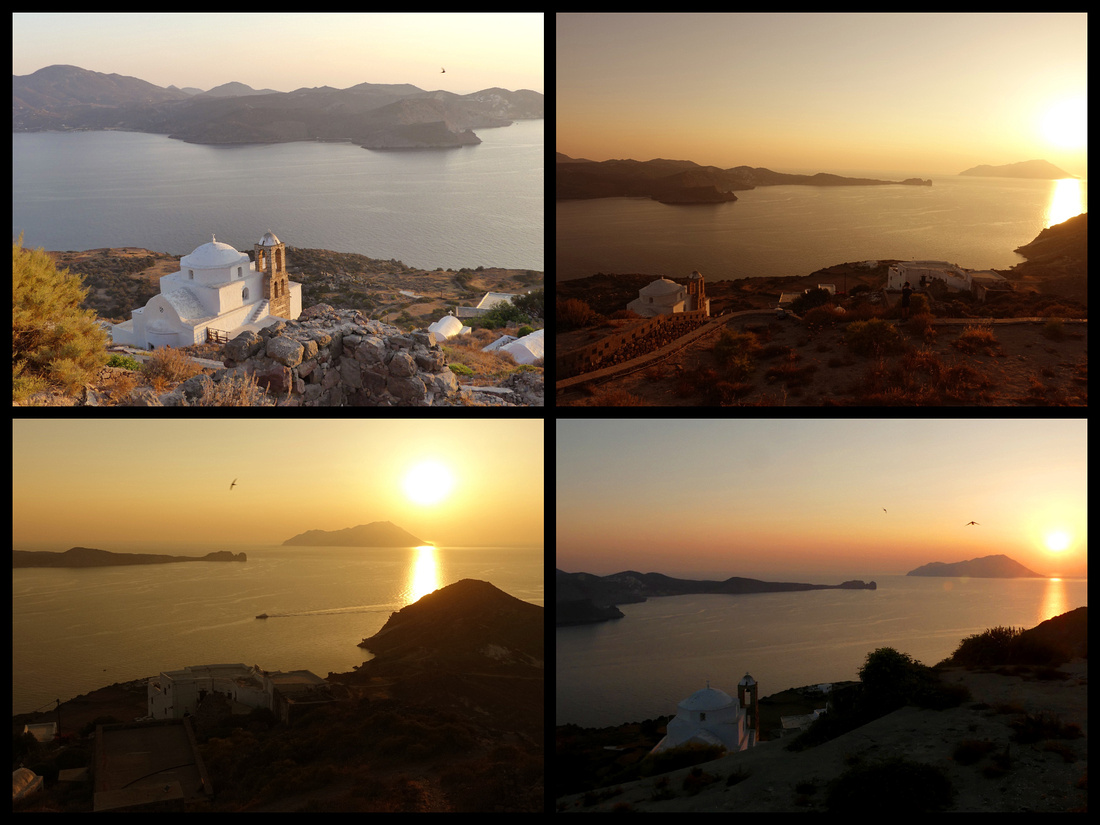

I arrived in Sifnos about 11:30 (the ferry leaves Santorini at 8:30, stops in Folegandros at 9:30, Milos at 10:30 and Sifnos at 11:30 – I hopped the same ferry every few days to the next island). Sifnos port town, Kamares, (population 250) is larger than Folegandros, but smaller than Milos. There is basically one ‘street’ (and the only cars allowed on it are those heading for the ferries, plus the bus). It is lined with tavernas – whose tables are across the street, right on the sand/water; ice cream shops; and jewelry/clothing/postcard shops. After the equivalent of about two blocks of that, is the beach and past that the bay curves around to a few more tavernas and a cute little chapel up a tiny hill. There are several streets of compact concrete houses climbing up the gentle hill. Between the ferry dock and the start of the tavernas is a tiny harbor with about 4 yachts and maybe a dozen small fishing boats. Numerous ferries come in and out of port several times a day, but don’t stay long enough to make it feel like a ‘port’. Once the ferries leave you are in a quiet (but not too quiet), fishing town that has a taste of tourism but not enough to make you feel like you are in Mykonos. There is a ‘supermarket’ on the main street (underneath the Stavros Hotel). There is so much interesting stuff crammed into this little store it is like going to a museum. Was able to get fruit/vegetables, yogurt, milk, water, juice, etc. There are supposedly two others but I didn’t see them.
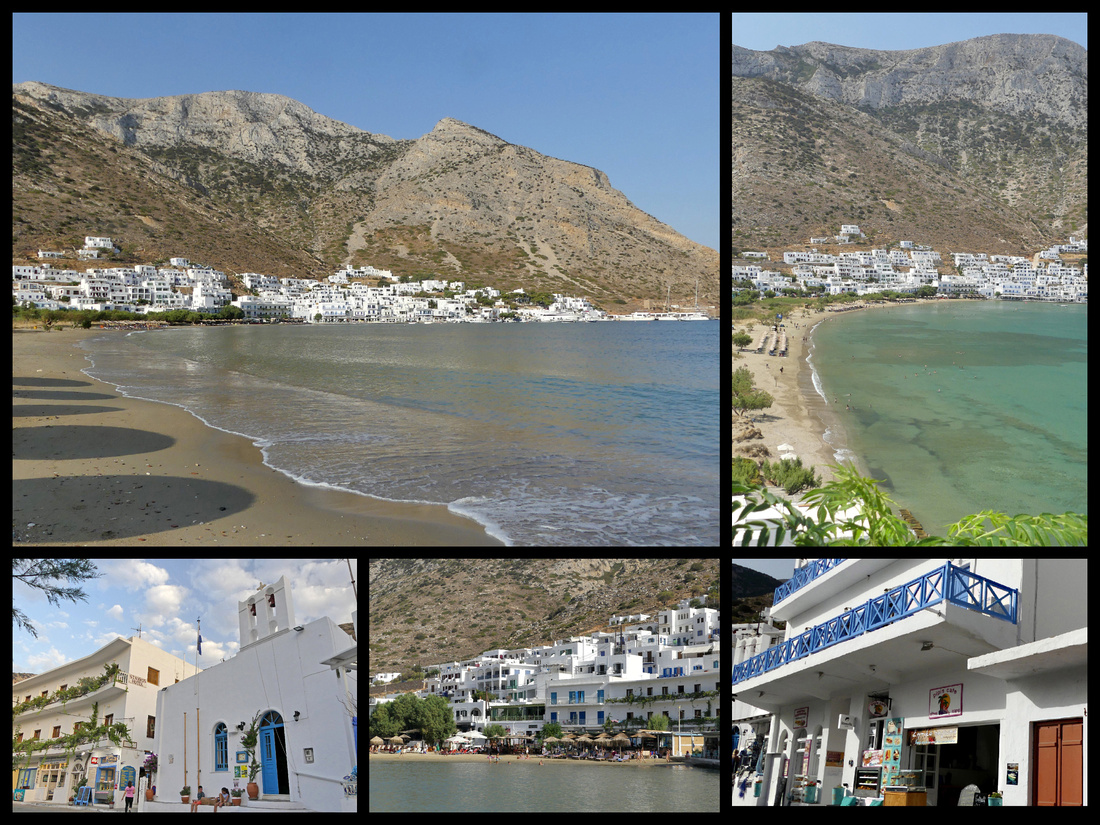

I was wondering how I was going to find my hotel, ‘To Steno’, given that google maps was really unclear, but I just started walking past the tavernas and saw a sign pointing down an alley, then another and there it was. There are three rooms and a reception, not sure if there are other rooms anywhere else. The proprietor checked me in and told me to come back at 2pm cause she hadn’t done the rooms yet.
So I went and checked out the town (that took about 20 minutes), then went to one of the tavernas on the water and had a leisurely lunch watching two kittens play with each other and the boats bobbing on the water. By then it was 2pm so I went back to ‘To Steno’ (1 minute walk) and the room was ready. Clean, spacious, bright, private little patio, decent AC and fridge. There is a lime tree surrounded by giant lavender on my patio.
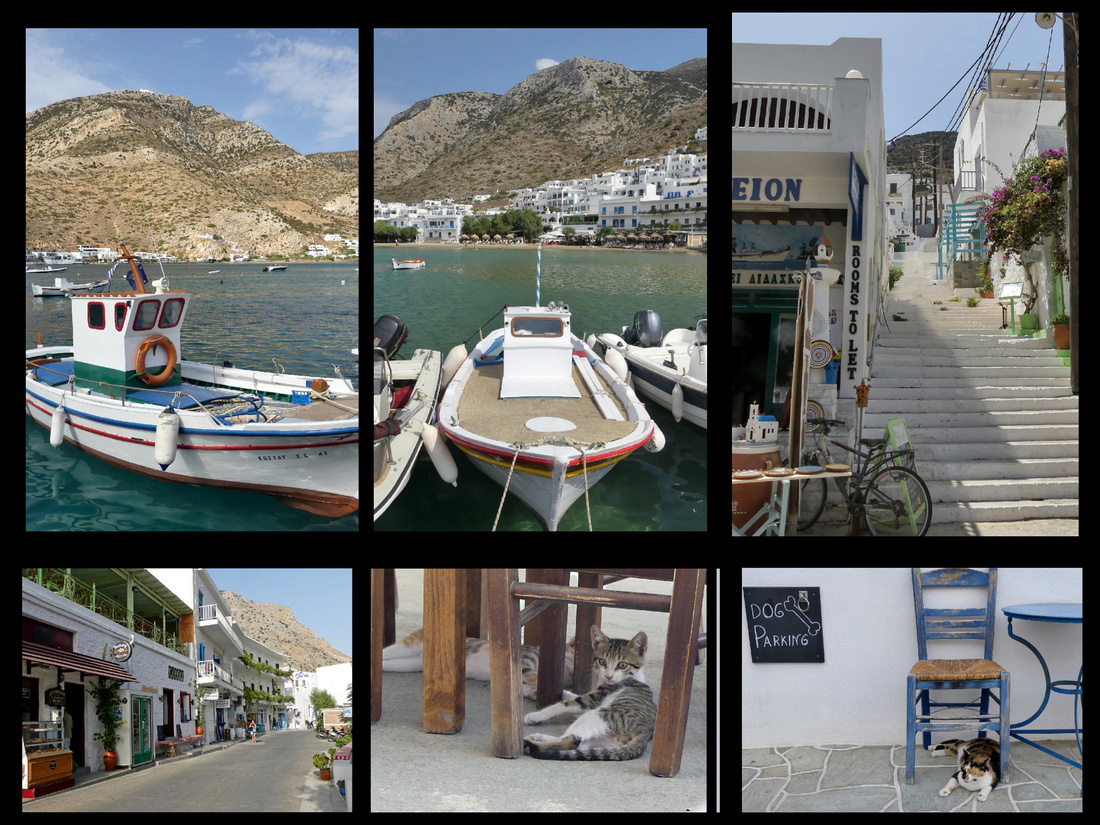

Sifnos Σίφνος population 2200. I had read that "Sifnos is full of beautiful Cycladic villages, the kind you see on postcards that made you want to go to Greece in the first place”. From a distance yes, Kamares and Apollina are quite scenic. ‘The villages of white cube houses crown it’s hill likes necklaces’ – that is true. Up close, they don’t hold a candle to Santorini, Naxos or Paros in the ‘picturesque’ department. However, Kastro is the epitome of a Greek Cycladic village.
Sifnos has long been a favorite of Greeks, especially Athenians, but now is popular with European tourists but I didn’t hear one American accent the whole time I was there. The mountains that frame Sifnos's deep harbor, Kamares, are barren and from the water the island looks as arid as the others, but inland there are terraced hillsides of mostly olive trees, some figs, occasional grape vineyards. There are still some of the beautiful slate and marble paths across the island, though most are now covered with asphalt to accommodate cars. Sifnos has been inhabited since 3000 BC. There are supposedly 365 churches and monasteries. Most of the churches are tiny one-room buildings, but they are scattered all over, not just in the villages. You can’t swing a cat on Sifnos without hitting a church. And there are cats wherever you look.
I’d read August can be hectic, rooms and cars booked, buses sardine-can full, but in July it was not at all crowded, buses maybe ¾ full, same with beach, restaurants at peak dining times, otherwise mostly empty. On numerous occasions I was totally alone on a path or street. Even in Kastro I almost never had to wait to shoot a picture without people.
Sifnos was the first island in Greece to hook up their plumbing to a purification and waste treatment plant, which makes Kamares one of the cleanest beaches in Greece and certainly the cleanest port. The beach is about a quarter mile stretch of sand that starts just past the ferry dock and circles around the harbor. There is an adorable church (Ag. Marina) part way up the hill side opposite the main part of town, only 100 steps, great sunset views from there.
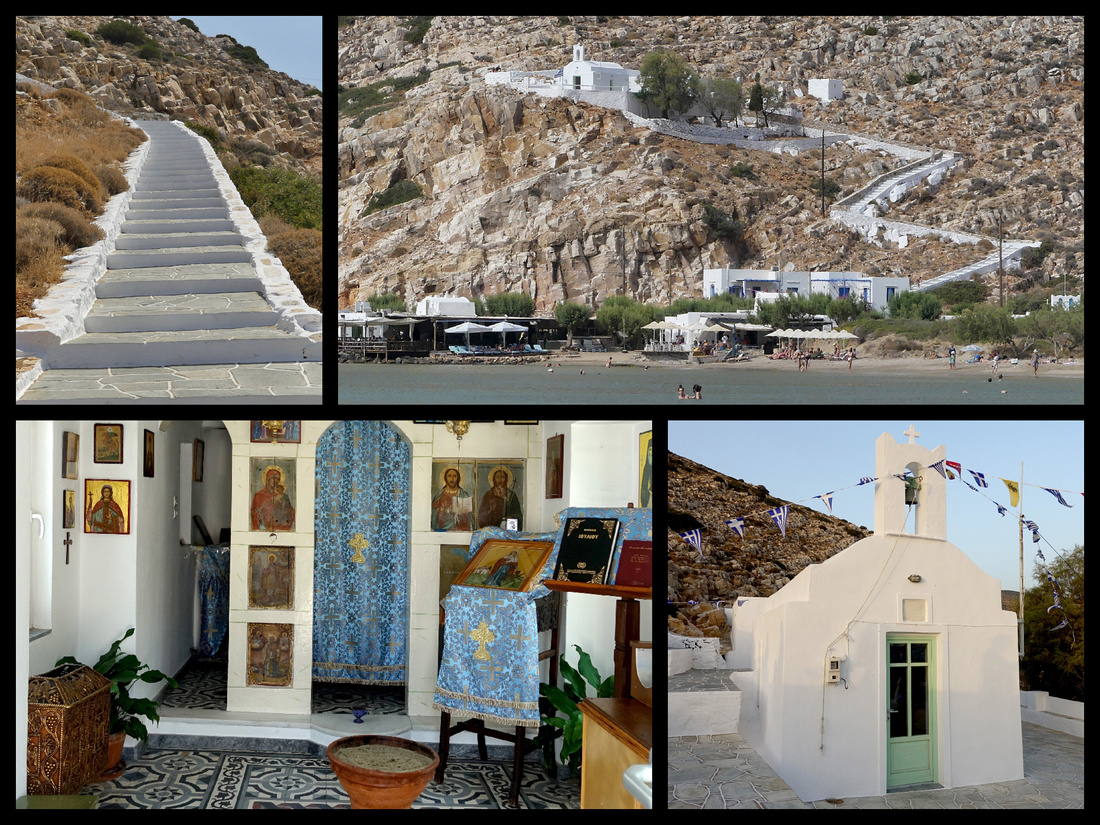

The centre of Hóra (buses go from Kamares up there hourly, takes about 20 minutes) is an amalgam of hilltop villages, which have merged over the years into one continuous community. The main town, near the center, is known as Apollonia (pop. 869). The town's name is thought to come from an ancient temple of Apollo on the site of the church of Panayia Yeraniofora. The second-largest town is Artemonas (800), ten-minute walk in the opposite direction from the bus stop, is thought to be named after an ancient temple of Apollo's sister-goddess Artemis. They kind of run into each other, plus three or four other once distinct villages that have now merged. Artemona is where the wealthy islanders built their mansions. So it has some Venetian and Neoclassical houses, that are unusual for a rural island like Sifnos.
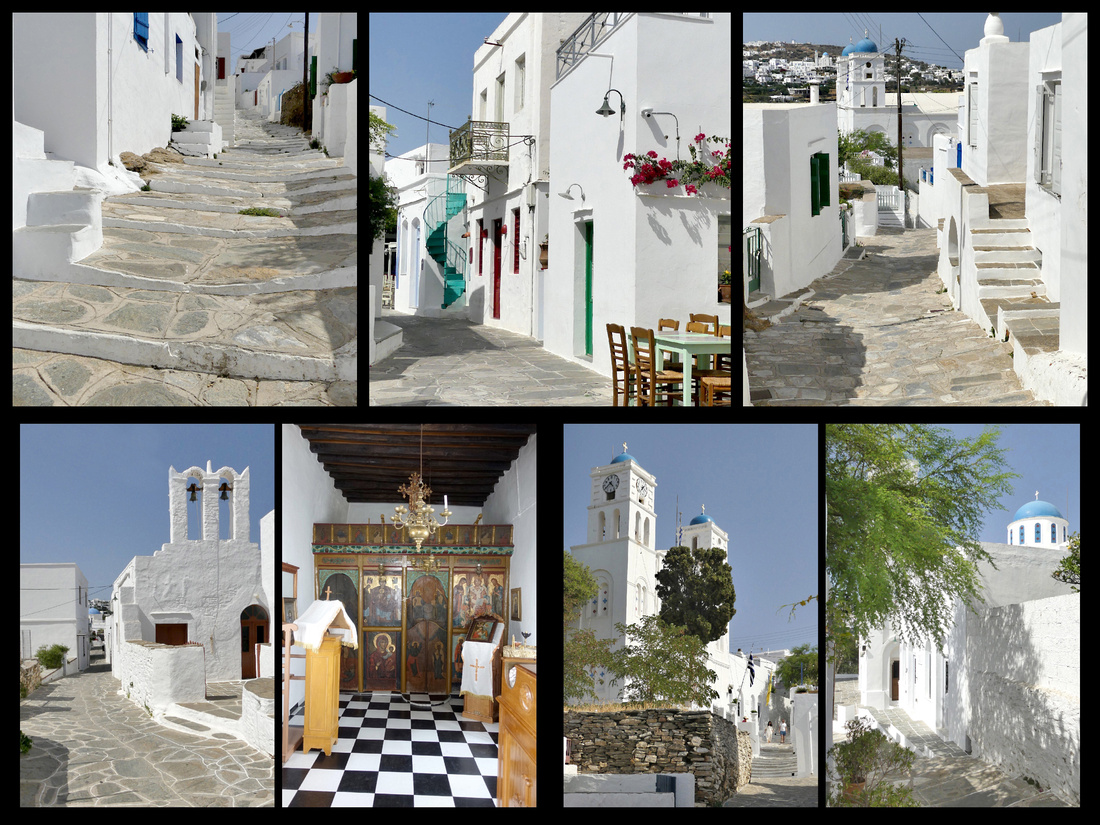

Center of the main village of Apollonia


Church and windmill at the far end of the village of Appolinia
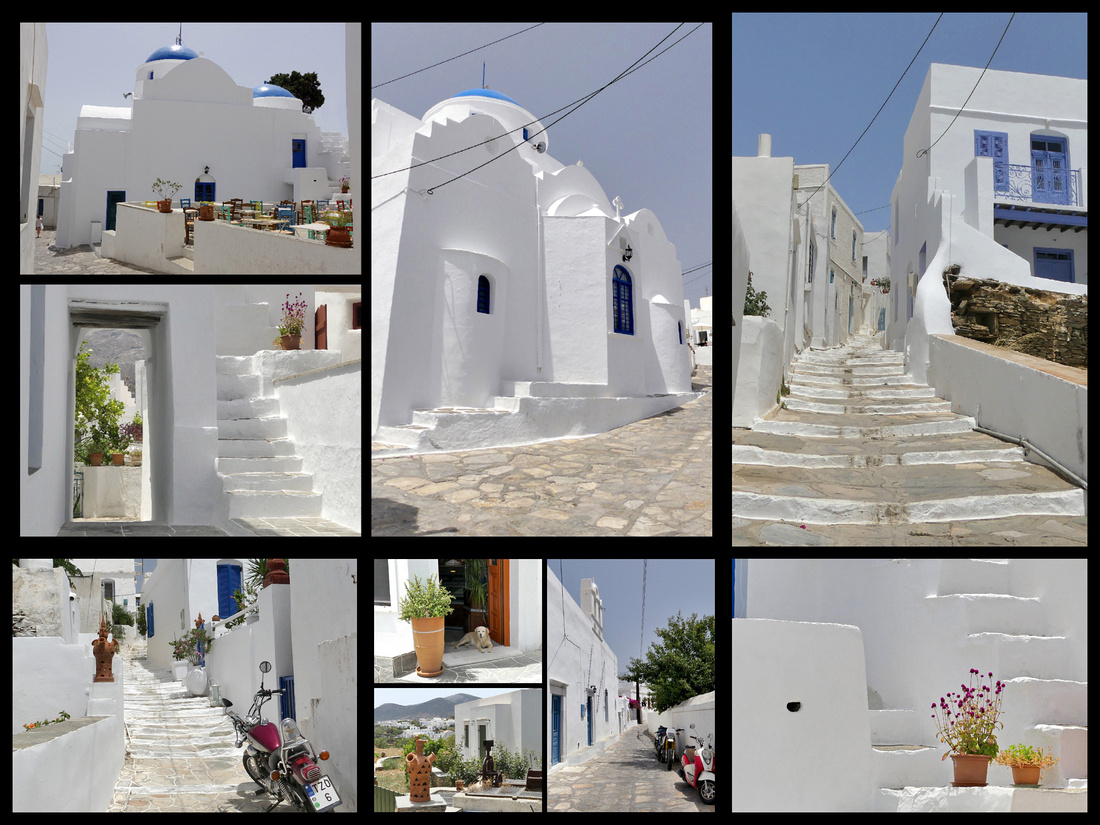

Center of the village of Artemonas
I really enjoyed the walk from Appolinia to Kastro. Where to start the walk was not immediately obvious. From the bus stop head up the main pedestrian ‘street’ a few feet till the ‘market’ and turn left on the flag-stoned path. It goes under the car road and then is pretty obvious. It goes for about 20 minutes or so through a terraced landscape of olive and fig trees, stonewalls, the occasional small plot of grapevines. Some dovecote buildings, a church all by itself in the middle of a field. Very scenic. Warm but not too hot and all downhill. Only one other woman on the path. The warm air intensifies the scents – almost smells like baking or cooking. Eucalyptus, wild thyme, rosemary, lavender. They say it’s a 45-minute walk, took me just over an hour but I stop to take a lot of photos.


The walk from Apollonia to Kastro through fields with stone walls and flagstone pavement, past vineyards and olive groves.
Eventually you come out on a car road. The path continued on the other side but was signposted for walking trails and none of it said Kastro. There was a woman walking her dog and I asked her and she said (more or less) follow the car road. After a couple turns (was clearly in a little community at this point) I came to a T intersection with no sign. I asked someone in a passing car, and she pointed and said ‘down’. The car road wasn’t quite as bucolic as the flagstone path but hardly any traffic and views of the towns in the distance, churches, windmills. Then the road started seriously going down, switch backing on it self. And then Kastro came into view. Gorgeous, perfect little white hill town against the sea. As I walked down, down, down and it was getting hotter and hotter, I was thinking 'I sure hope there is a bus back'. And just as I got there a bus went by. Checking my schedule there would be another one in 2 hours. Turned out to be almost perfect amount of time. Just before town is one little chapel on one side of the road, three windmills, and the double church of Ag. Stefanos and Ag. Ioannis Kalivittis.
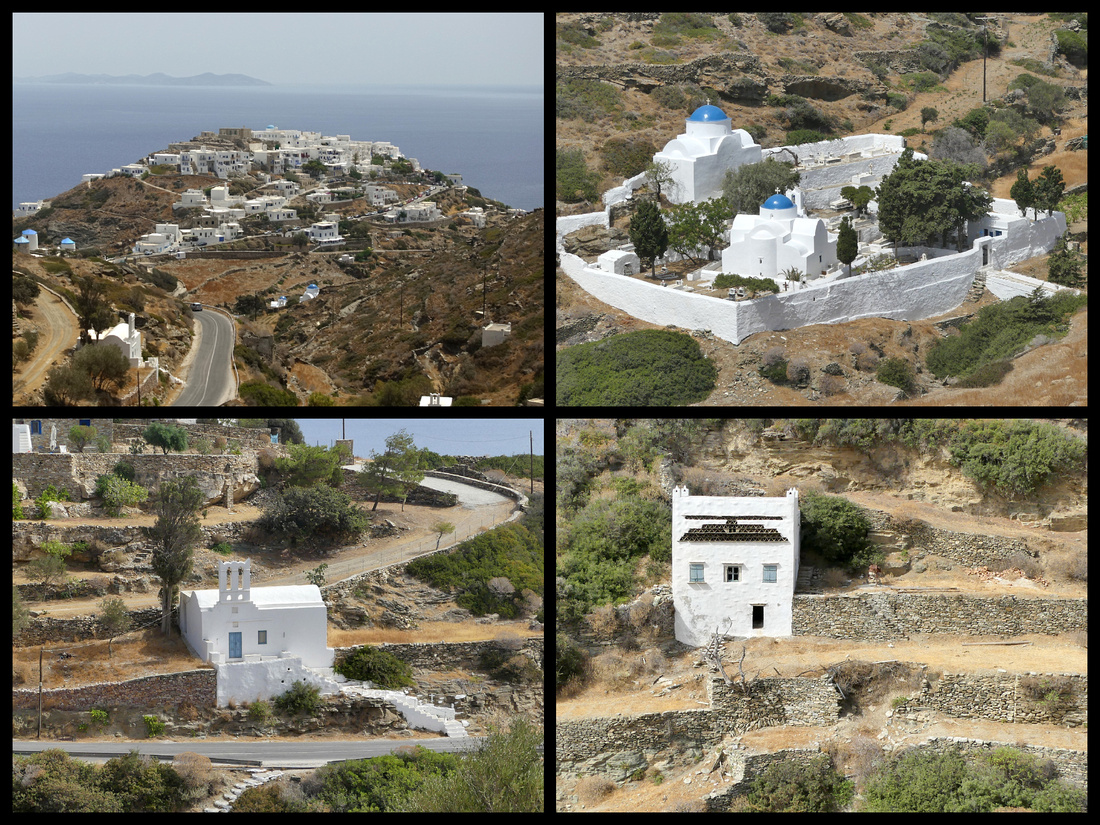

The village of Kastro on a hill overlooking the sea, as seen from the road from Appollina. Just before the village is a small church and some windmills on one side of the road and a 'double' church on the other.
Kastro (population 118), one of the best-preserved medieval towns in the Cyclades, built on the dramatic site of an ancient acropolis. It was the capital of the island during ancient times until 1836. It is downhill from Appolonia but it’s on top of a high cliff over the water on the island's east shore and today remains very medieval looking. This is the picture postcard town of Sifnos. Until several decades ago, it was almost entirely deserted; as tourists began to infiltrate the island, Kastro sprouted a few cafes. Whitewashed houses, some well-preserved and others eroding, adjoin one another in a defensive ring abutting a sheer cliff.
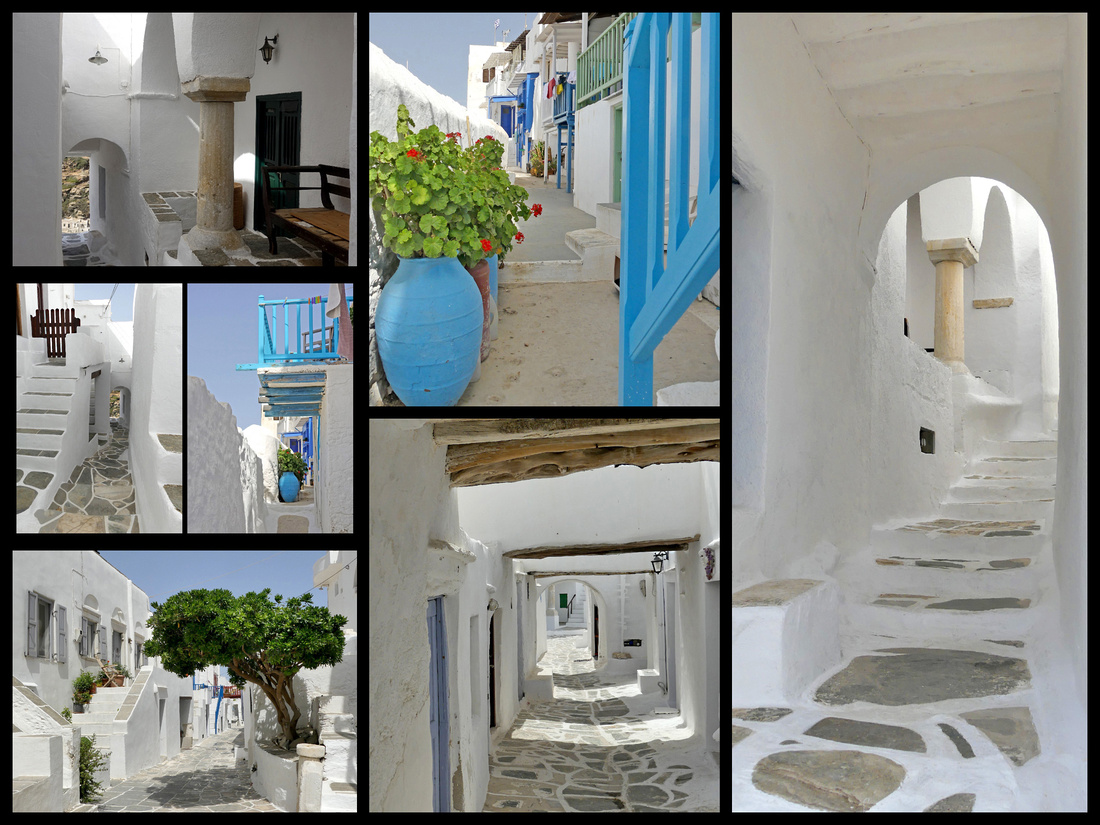

Kastros has been inhabited for over 3000 years. To protect the town from pirates there were only five entrances in the walls (formed by the houses), which enclosed it. These could be locked by iron gates. Today when you enter the town you go through tunnels and passageways into a labrynth of tiny streets wide enough for only two or three people to walk abreast. On the seaside of the village a small churche on a rocky promontory, hundreds of steps down from the village: the Church of the Seven Martyrs. It looks like the church from the wedding scene in Mamma Mia only down instead of up.
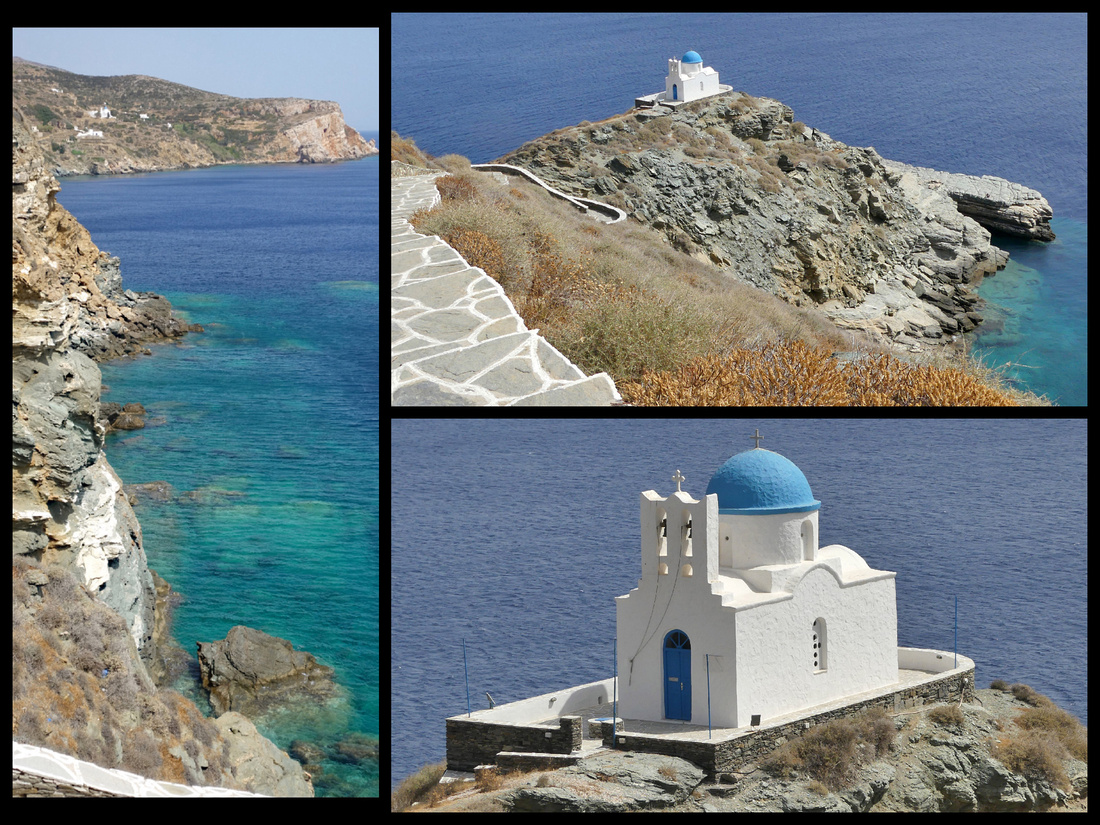

I noticed that the water around the promontory had striking differences in color from turquoise to light blue to dark blue – and this phenomenon occurs all over the Aegean and Mediterranean seas. So I looked it up. The reason the ocean is blue is due to the absorption and scattering of light. If there are any particles suspended in the water, like algae, that absorb certain wavelengths of light, it will alter its characteristics. When water is very deep there are no reflections off the sea floor, the water appears as a very dark navy blue. In tropical waters there is often very little suspended in the water so it is clear and takes the natural blue of pure water. Some types of algae and other microorganisms will make the water look green or turquoise, especially when it is not very deep. Also, the Mediterranean Sea does have tides, but they are of a very low amplitude, a few centimeters compared to the Atlantic where tides are a meter or more.
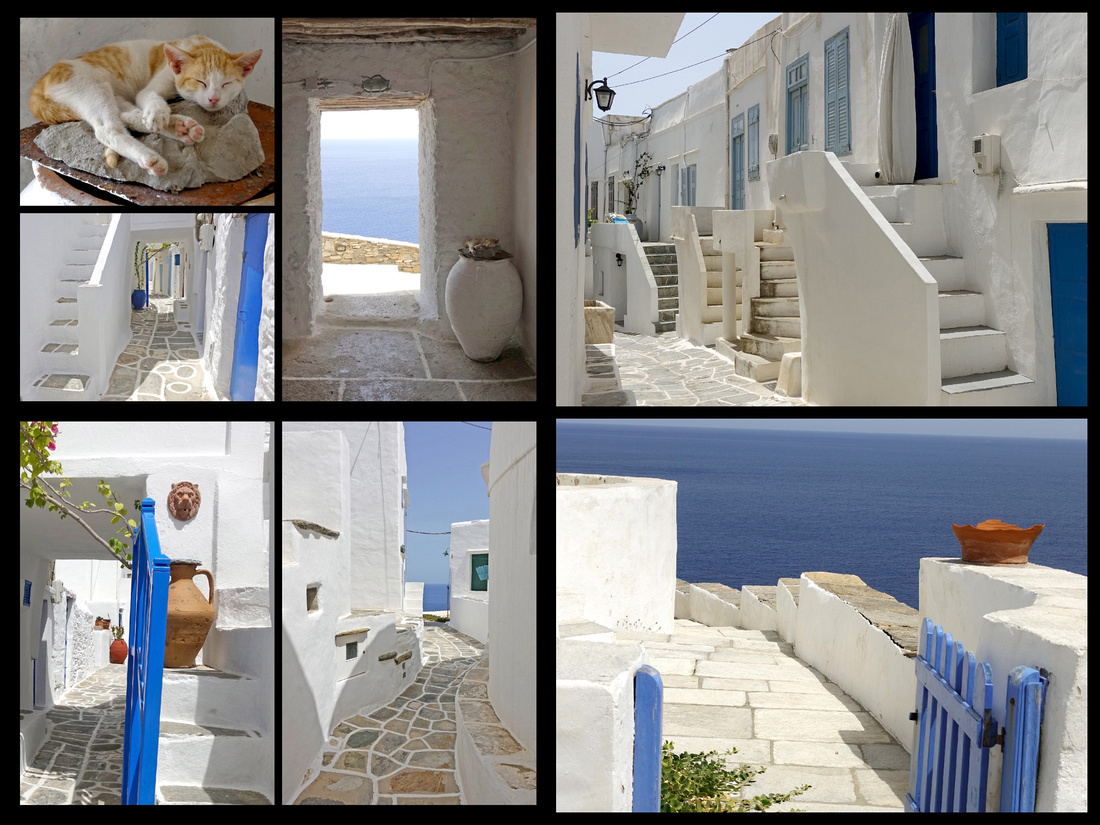

Center of medieval Kastro
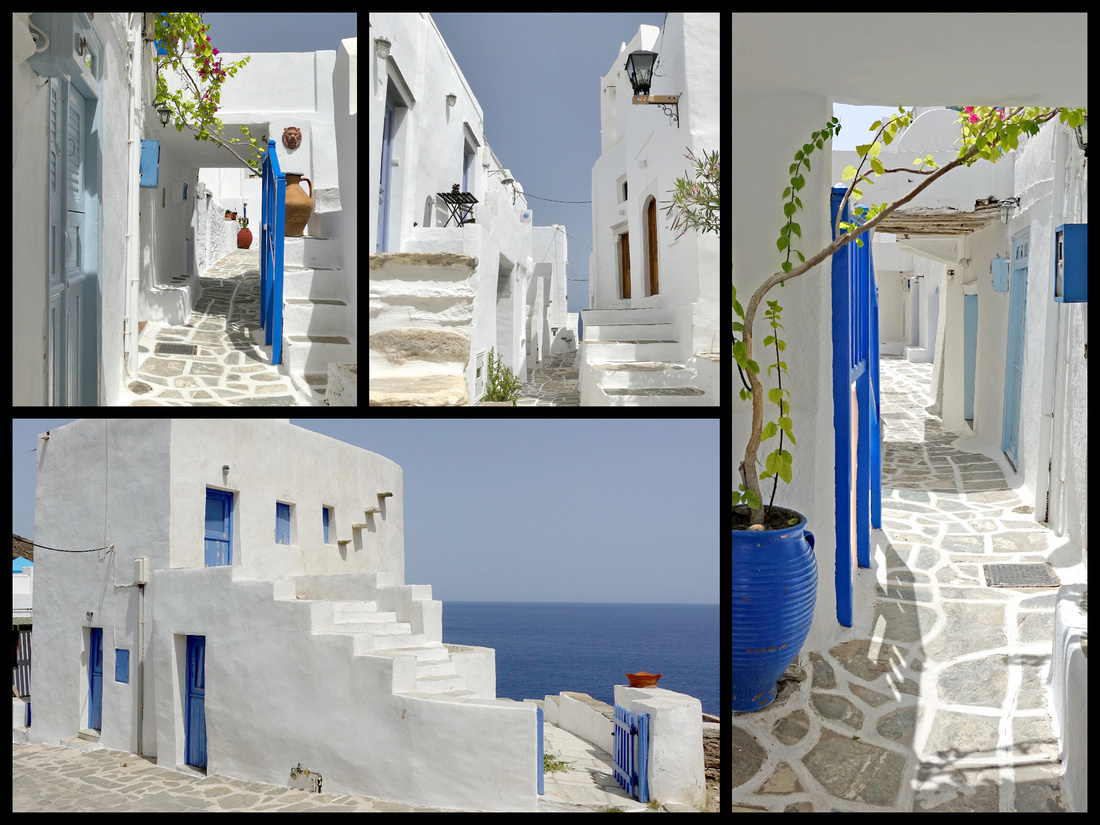

What I did with three days on Sifnos. The first afternoon I took the bus up to Apollonia but my timing was terrible – it was the middle of the afternoon and very hot and of course nothing was open and the streets deserted. OK for shooting photos but the atmosphere and the heat were less than perfect. Fortunately the beach in Kamares is wonderful so cooled down back there. On my second day I went back up to Apollonia in the morning, much nicer, and then began the highlight of my time on Sifnos, the walk to Kastro. The walk was idyllic and Kasro one of the most picturesque villages I’ve seen in Greece. The third day I had planned a day trip to the next island over, Serifos, but a lazy day on the beach seemed like a better idea at the time (of course now I wonder what Serifos is like, oh well, will have to return). All three evenings, after dinner at various tavernas on the water I walked up to the little chapel on the hill for sunset.
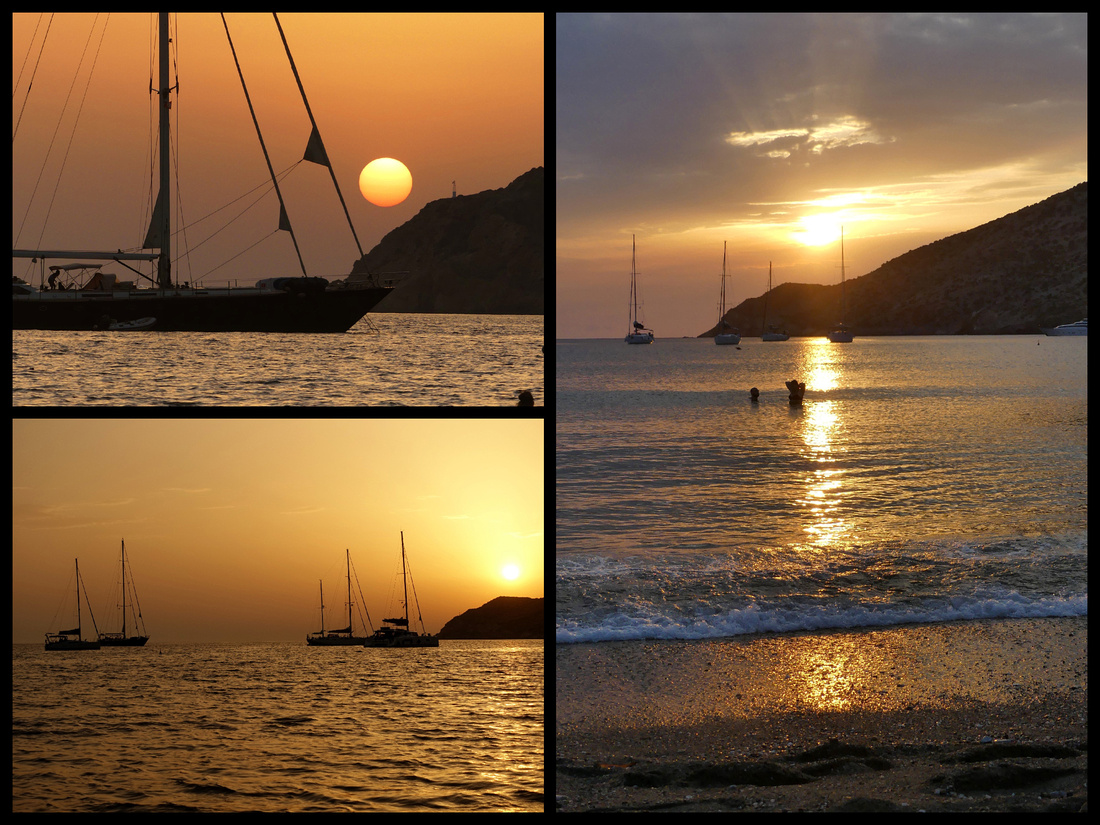

My last two days in Greece were back to Santorini (it is a three hour ferry from Sifnos) where in addition to just wandering and gazing at the view in Fira and Oia, I visited the inland village of Emporio. I then flew to London for five days before returning home. And while after a 37 day trip I was glad to be home, within about two days I wished I were back in Greece.


The hotels: Left: Vardia Bay Studios, Folegandros Center: Hotel Delfini, Milos Right: To Steno, Sifnos
